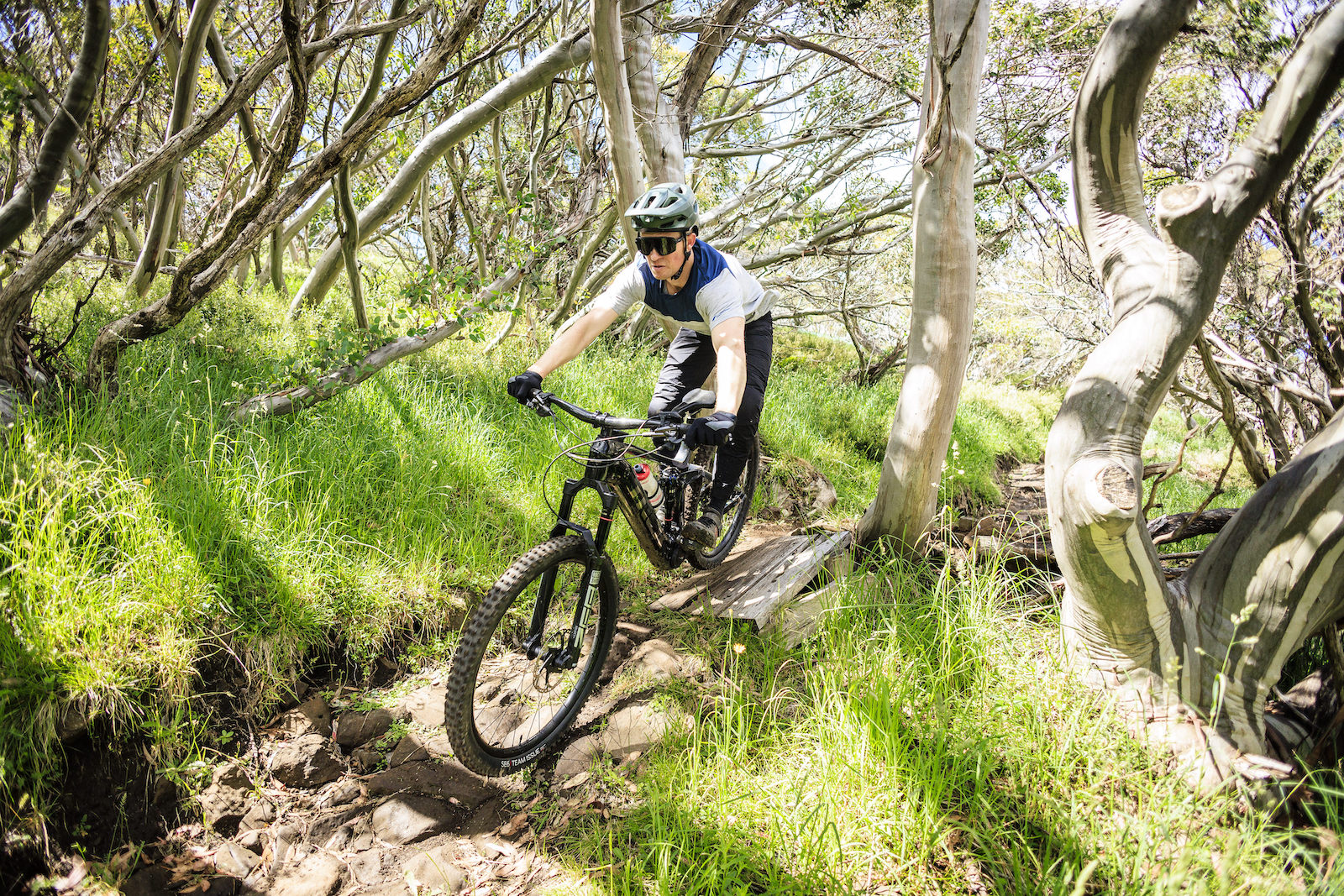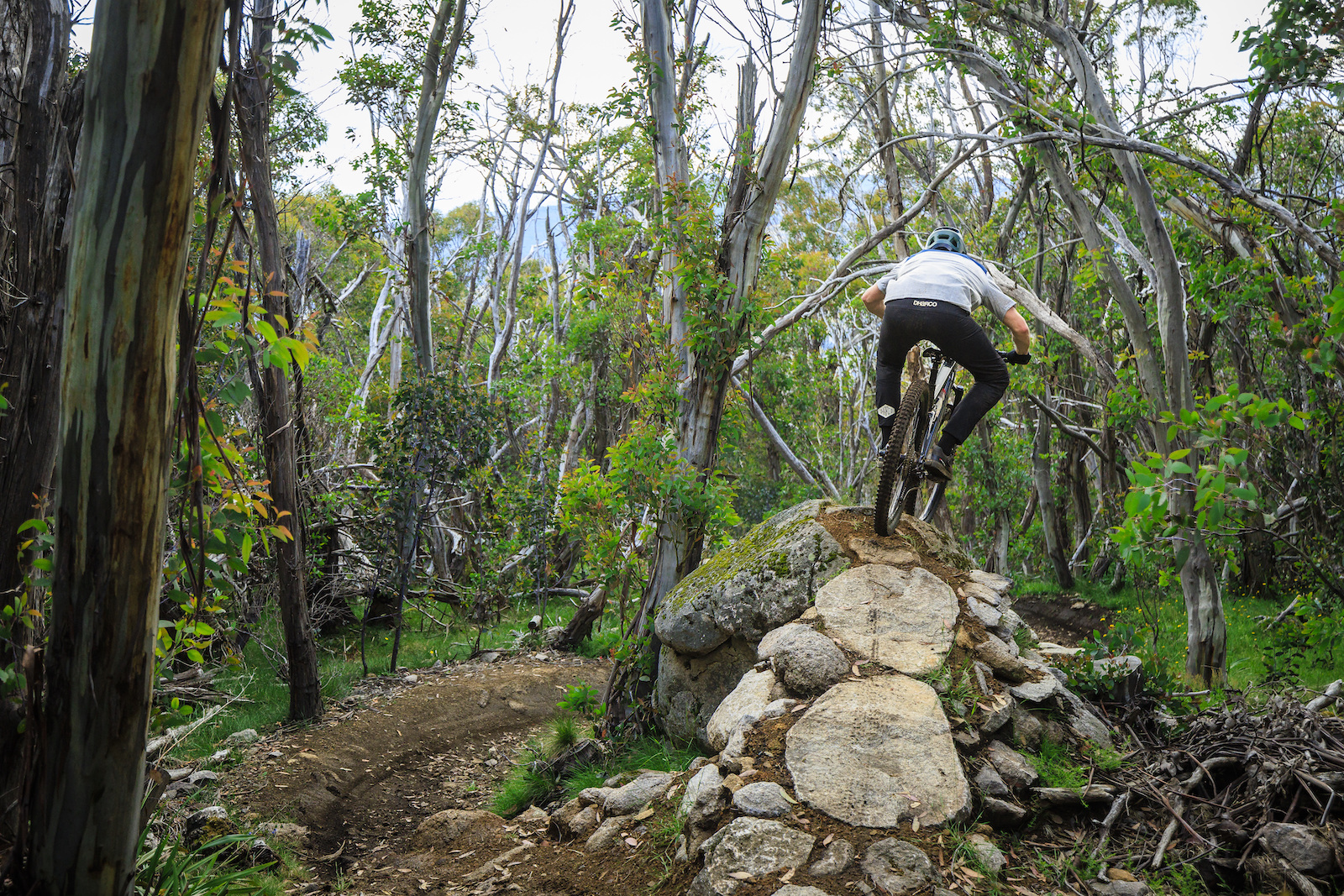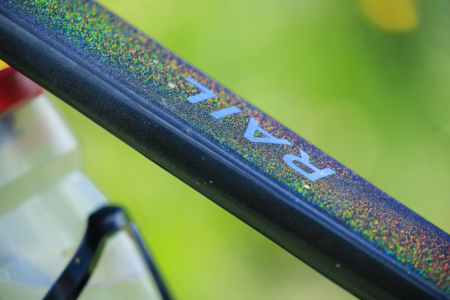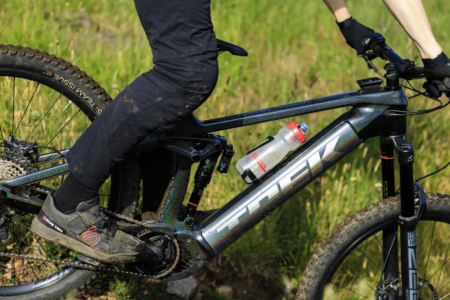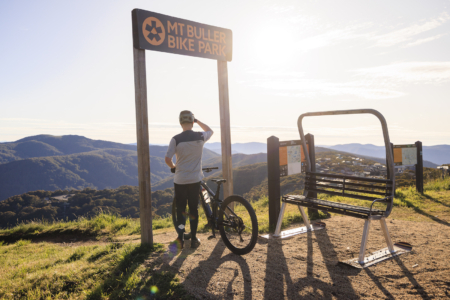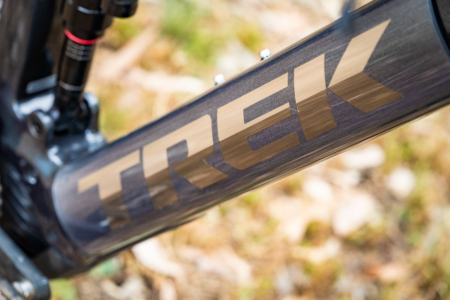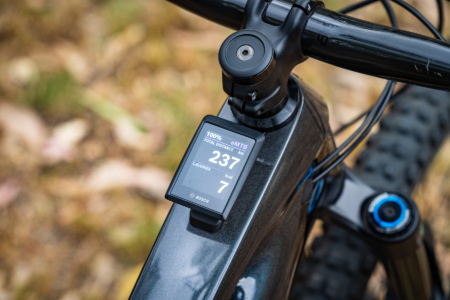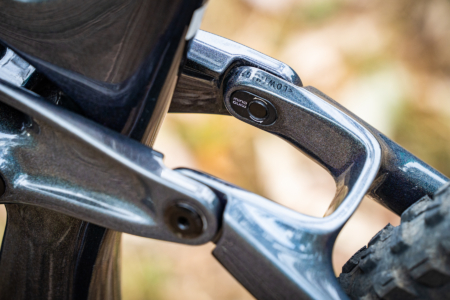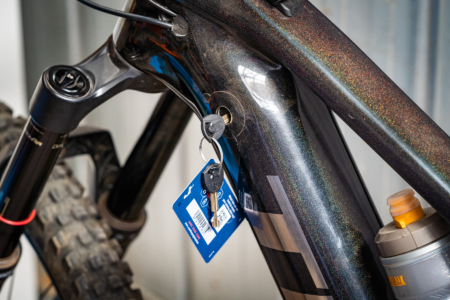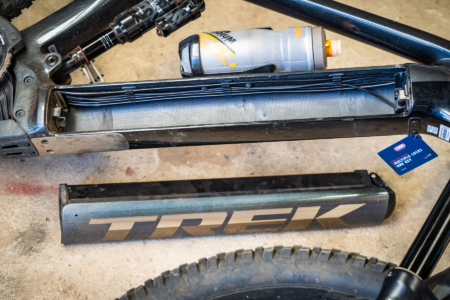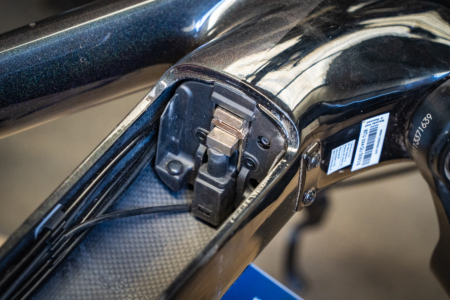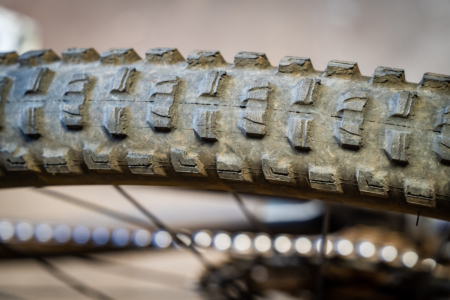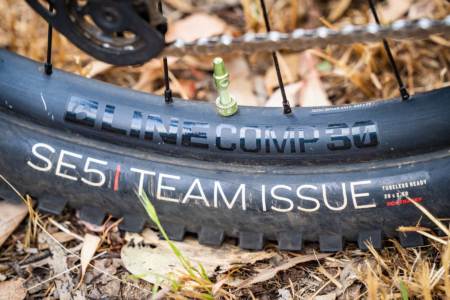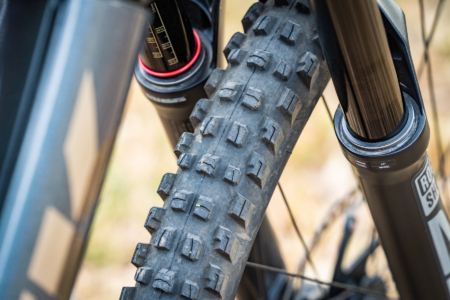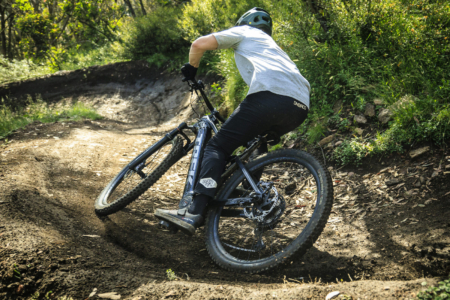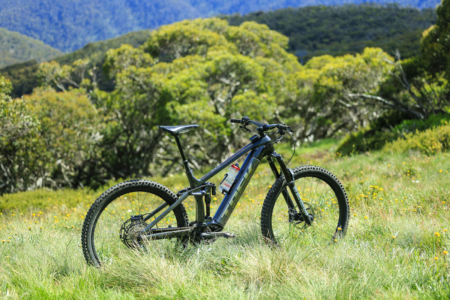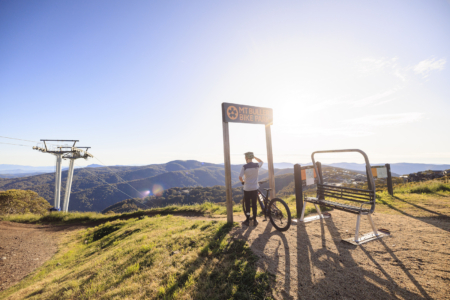Justin & Dan review the Trek Rail
Since it was introduced back in 2019, the Trek Rail has joined the likes of the Specialized Levo, Merida eOne-Sixty and Norco Sight VLT as one of the stalwarts of the Aussie e-MTB scene. Available in alloy and carbon across a wide range of price points, and powered by the excellent Bosch Performance Line CX motor, the Rail has grown to become a very popular electric mountain bike.
We last reviewed a carbon Trek Rail 9.8 in 2019 and an alloy Trek Rail 9 in 2021. Though they weren’t perfect, we were mighty impressed by the quality of the suspension and the balanced handling. Trek has since updated the Rail lineup, incorporating a suite of improvements that are designed to take its technical prowess to a whole new level. To see how all the changes play out on the trail, we got our hands on this shiny Trail Rail 9.8 XT to put through the wringer.
Watch our Trek Rail video review here:
For a full-powered e-MTB with dual 29in wheels, the Rail is arguably one of the best-handling bikes in its category.
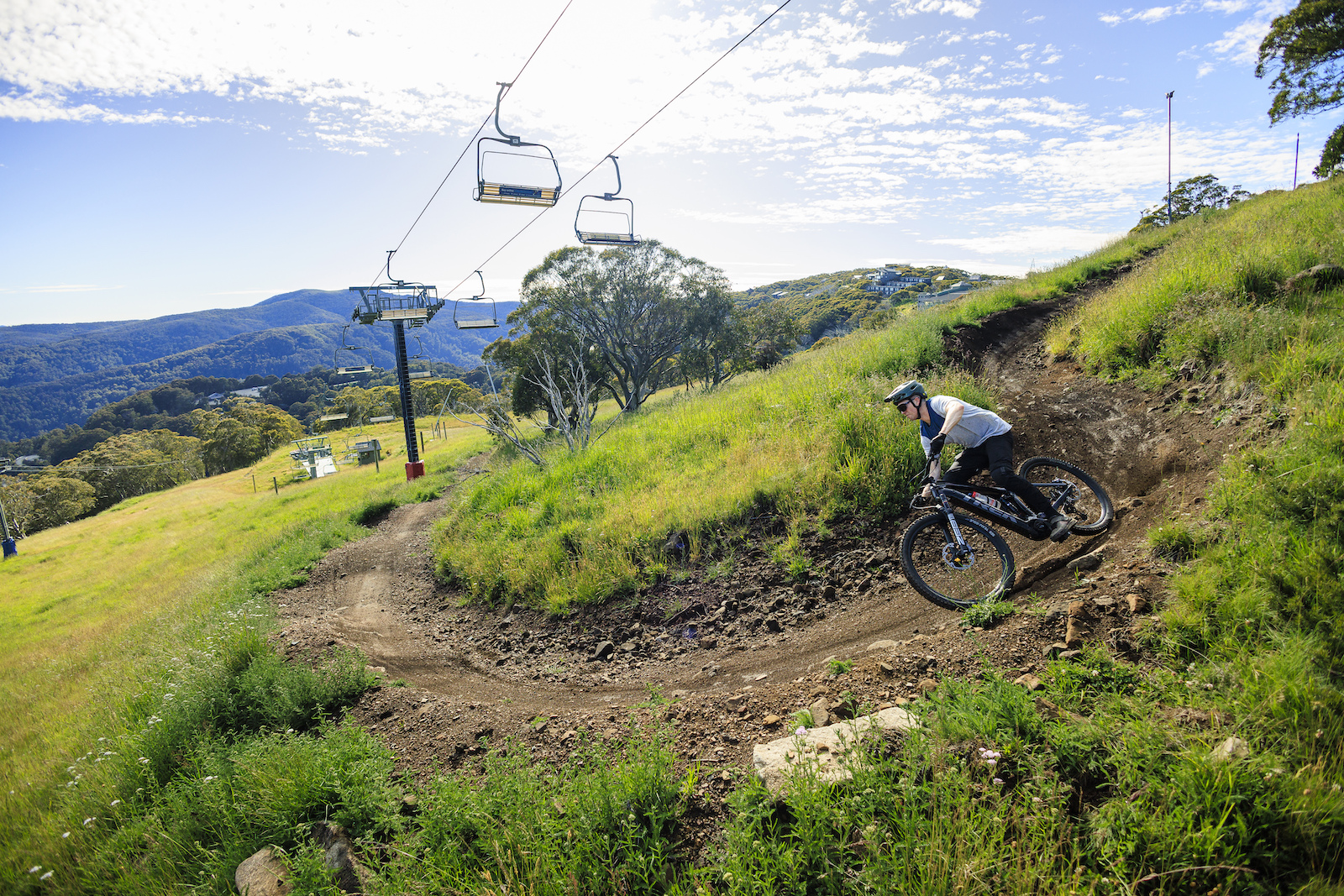
An overview of the Trek Rail
Designed to cover everything from backcountry trail riding through to e-Enduro racing, the Trek Rail features a 160mm travel fork and 150mm of rear wheel travel. It comes fitted with 29in wheels, though by flipping the Mino Link into the High position, Trek says you can run the Rail as a mullet with a 27.5in rear wheel.
As with almost every Trek full suspension mountain bike, the Rail is built around the ABP four-bar suspension platform. The most rearward pivot is concentric to the thru-axle, which Trek says helps to decouple braking forces from the suspension.
The top models are equipped with a custom RockShox Super Deluxe Ultimate RT3 shock. Codeveloped between RockShox and Trek, this fancy shock features the unique Thru Shaft damper design, and as we’ll discuss shortly, is a big contributor to the Rail’s overall ride quality.
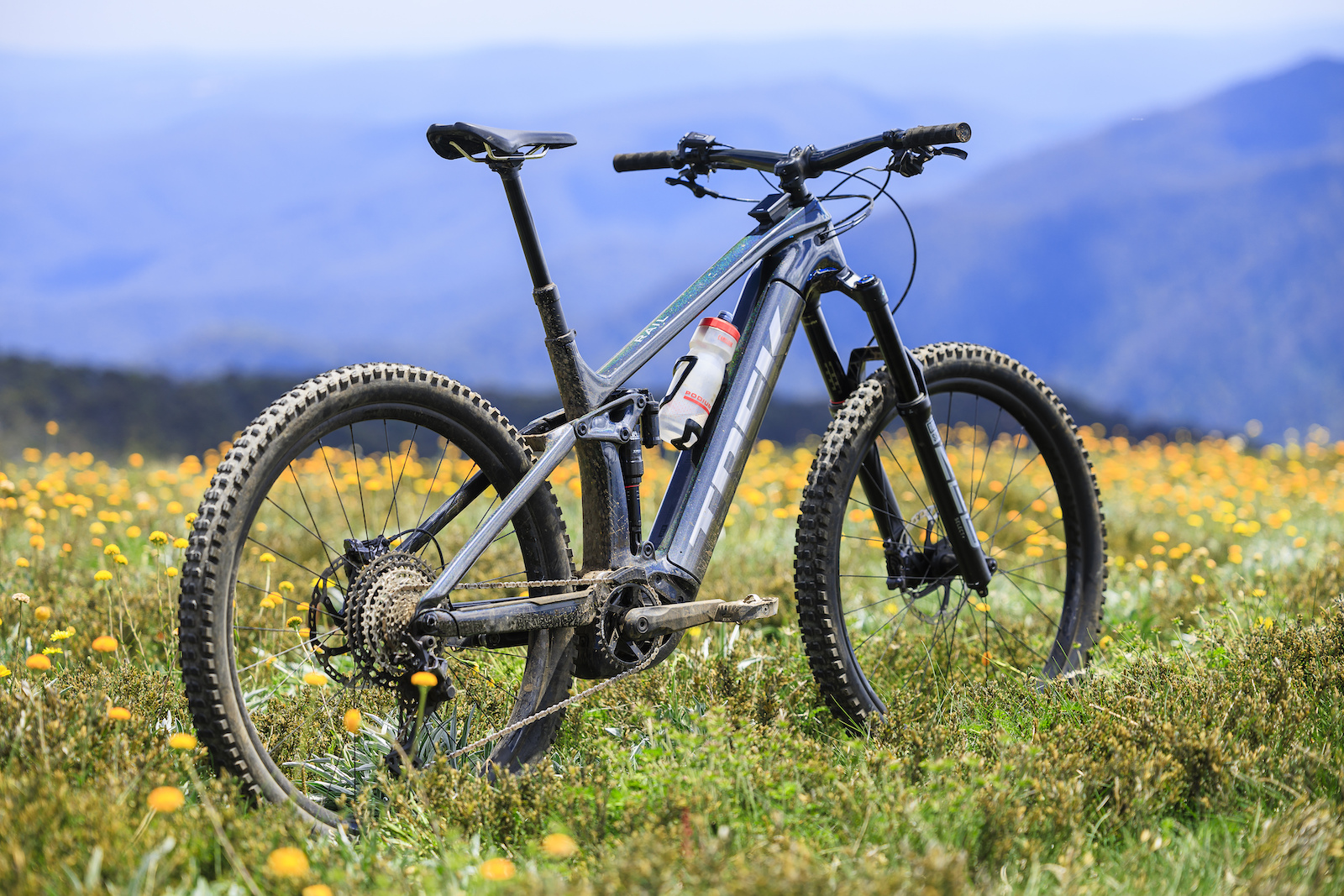
Frame & geometry updates
While the alloy frame remains unchanged, the Trek Rail’s carbon frame has been beefed up significantly.
The seat tube has swollen to a 34.9mm diameter, increasing chassis strength and allowing you to fit a modern long-stroke dropper post. Trek has also adopted the new 1.8in head tube standard to bolster front-end stiffness, while improving the proportions with big travel forks like the RockShox Zeb and Fox 38.
Also new is the Knock Block 2.0 headset. The steering limiter still prevents the handlebar controls from smacking into the frame, but a larger turning radius means it’s entirely unnoticeable on the trail.
Along with the beefier frame, Trek has also updated the Rail’s geometry. The most significant change is the seat tube angle, which steepens by almost two degrees to 76.7°. The reach has increased, growing by 12-22mm depending on the frame size, and the head angle is also a hair slacker at 64.2° in the Low geometry setting.
One number that hasn’t changed is the 448mm rear centre length, which is about as short as you’ll find for a 29er fitted with a Bosch motor. In comparison, the Scott Patron gets a 454mm rear centre, while the Avanti Hammer-E LT comes in at 462mm.
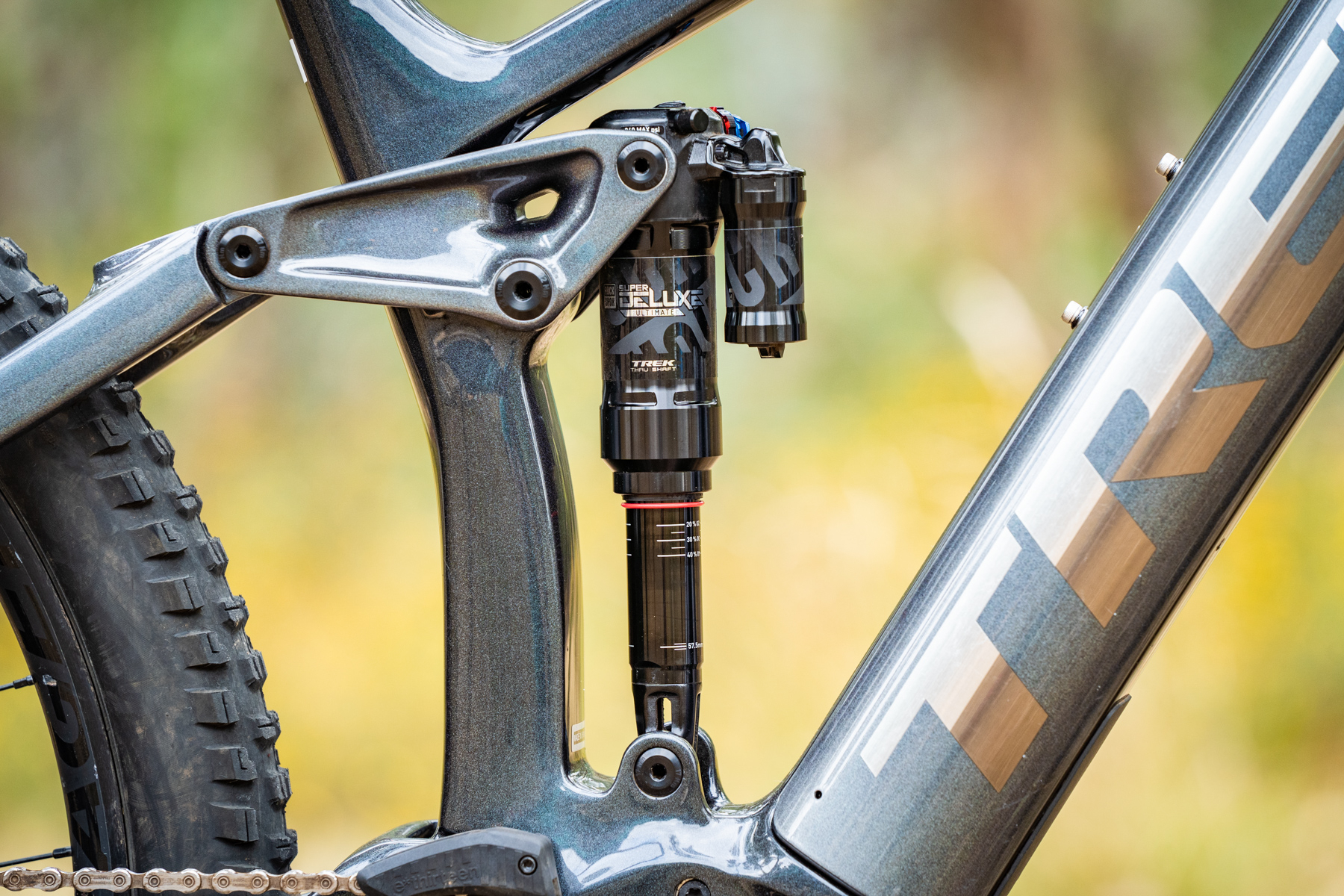
Bosch smarts
The latest carbon Trek Rail also updates to the Bosch Smart System. The tidy Kiox 300 display is tucked out of the way behind the headset, while the LED controller sits next to the left-hand grip.
Powering the Rail is the Bosch Performance Line CX motor and a 750Wh PowerTube battery. You can charge the battery in situ, or it can be easily removed from the frame with a key for charging separately.
Compared to previous generation Bosch systems, the latest Smart System provides you with far greater functionality and the option to tune the motor. If you’re curious to learn more about its full potential, check out our Bosch Tuning Tips article for everything you need to know.
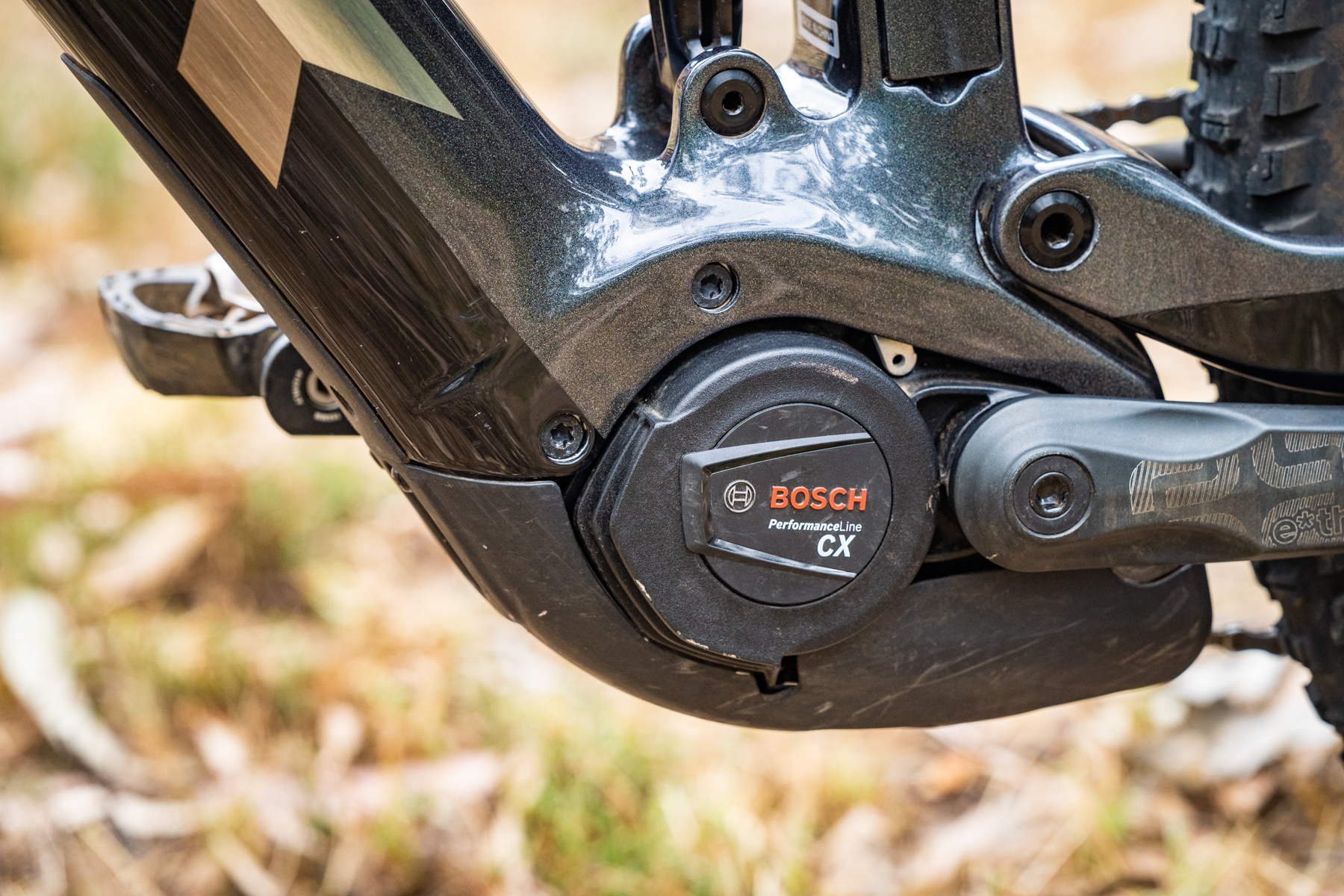
Trek Rail price & specs
There are five models in the current Trek Rail lineup; two with alloy frames and three with carbon frames.
Prices kick off at $7,499 AUD for the Trek Rail 5, which is pretty good for a Bosch-equipped bike. However, it’s worth noting that the alloy models do carry over the previous generation frame, which uses a smaller 500Wh or 625Wh battery along with an older display and controller.
On the other side of the price spectrum is the Trek Rail 9.9 XTR, which sells for $15,999 AUD. This model is also available to customise through the Project One bike builder, for those who want something a little different to the norm.
As blingy as the 9.9 model is, we’re not particularly interested in the additional electronic gizmos it comes with. Instead we requested the Trek Rail 9.8 XT to review, as we think this is the bike that more people are likely to purchase. Despite selling for $3,500 less, it still features the same carbon frame, rear shock and Bosch Smart System as the 9.9 model, albeit with a more practical parts spec.
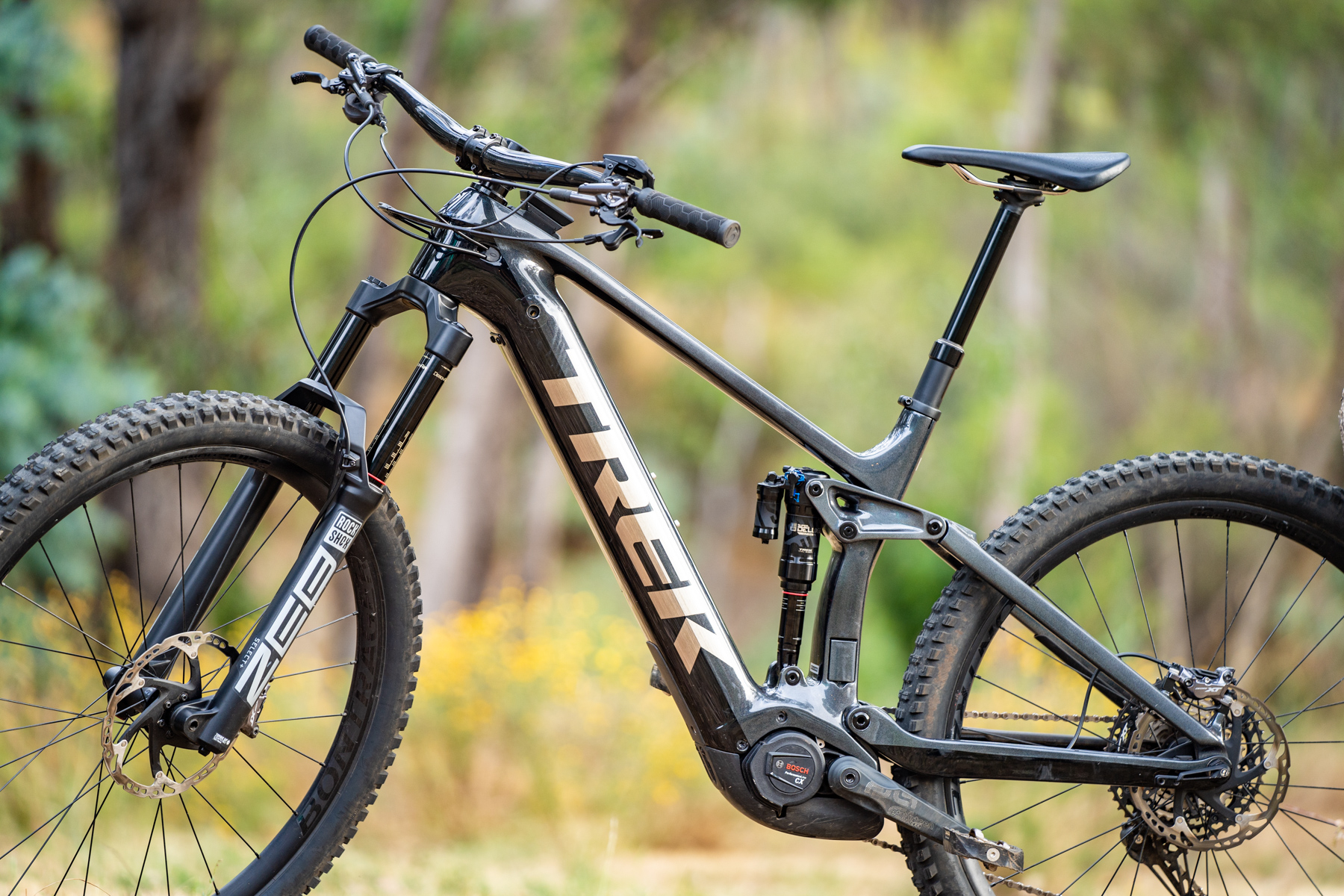
What about the 2023 Trek Rail?
It’s worth acknowledging that since receiving our 2022 test bike, Trek has quietly introduced some updates for the 2023 iteration of the Rail.
These changes are predominantly based around the user interface, with the alloy Rails updating to the Bosch Smart System with the LED controller and Kiox 300 display. The carbon Rails will then come with the newer Mini Remote and System Controller. Otherwise the frames, motors, batteries, and the majority of the component spec will be identical between the 2022 and 2023 models.
For those eager to wait for a 2023 Trek Rail model, we’ve been informed that stock will begin arriving in Australia in April.
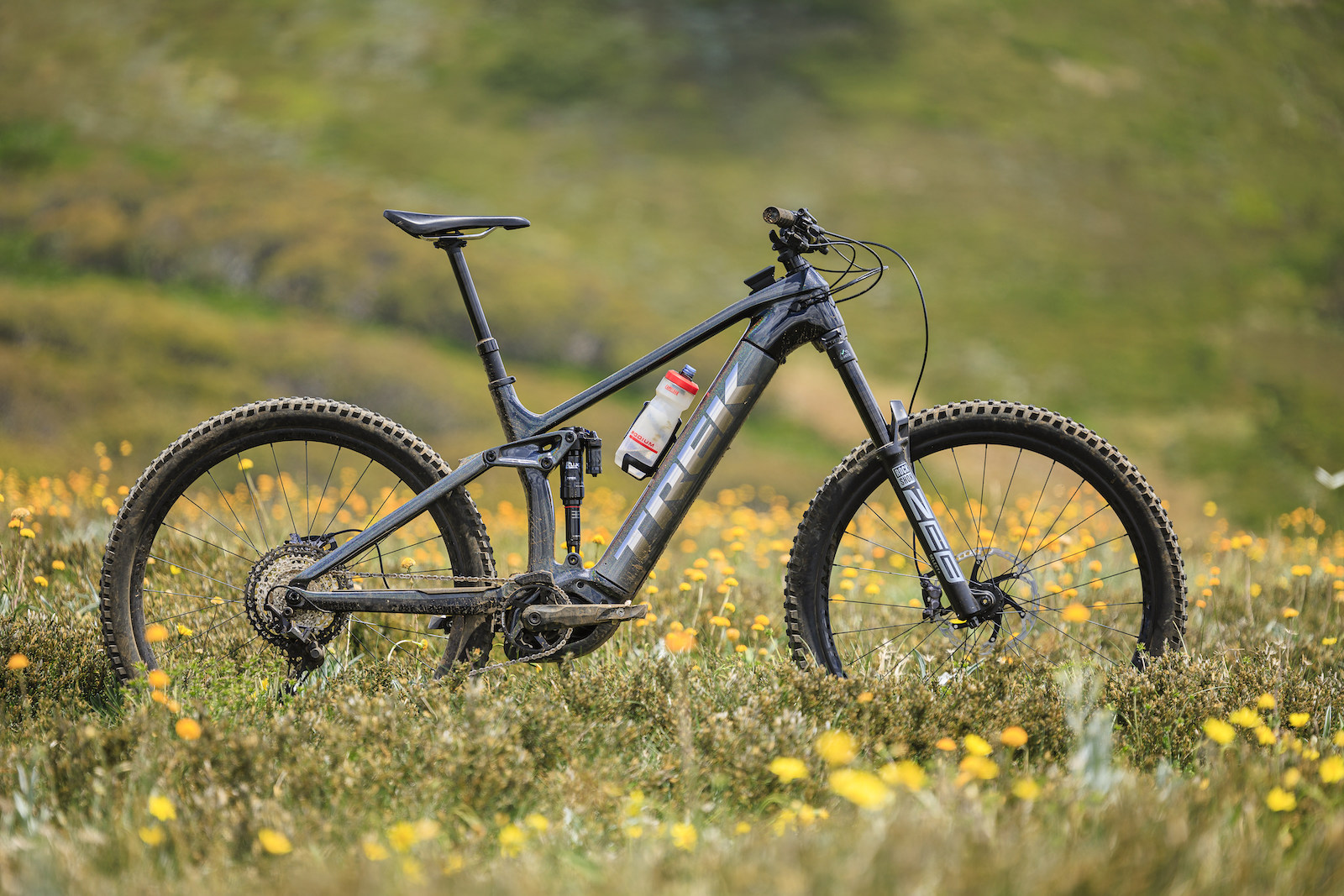
2022 Trek Rail 9.8 XT
- Frame | OCLV Mountain Carbon, ABP Suspension Design, 150mm Travel
- Fork | RockShox Zeb Select+, Charger 2.1 RC Damper, 44mm Offset, 160mm Travel
- Shock | RockShox Super Deluxe Ultimate RT3, 230×57.5mm
- Drive Unit | Bosch Performance Line CX, 85Nm
- Battery | Bosch PowerTube 750Wh
- Wheels | Bontrager Line Comp, 30mm Inner Width
- Tyres | Bontrager SE6 Team Issue 2.5in Front & SE5 Team Issue 2.5in Rear
- Drivetrain | Shimano XT 1×12 w/e*13 Plus 34T Crankset & 10-51T Cassette
- Brakes | Shimano XT 4-Piston w/203mm Rotors
- Bar | Bontrager Line Pro OCLV Carbon, 27.5mm Rise, 780mm Width
- Stem | Bontrager Line Pro, Knock Block, 45mm Length
- Grips | Bontrager XR Trail Comp Lock-On
- Seatpost | Bontrager Line Elite, Travel: 150mm (M), 170mm (L), 200mm (XL)
- Saddle | Bontrager Arvada
- Confirmed Weight | 23.94kg
- RRP | $12,499 AUD
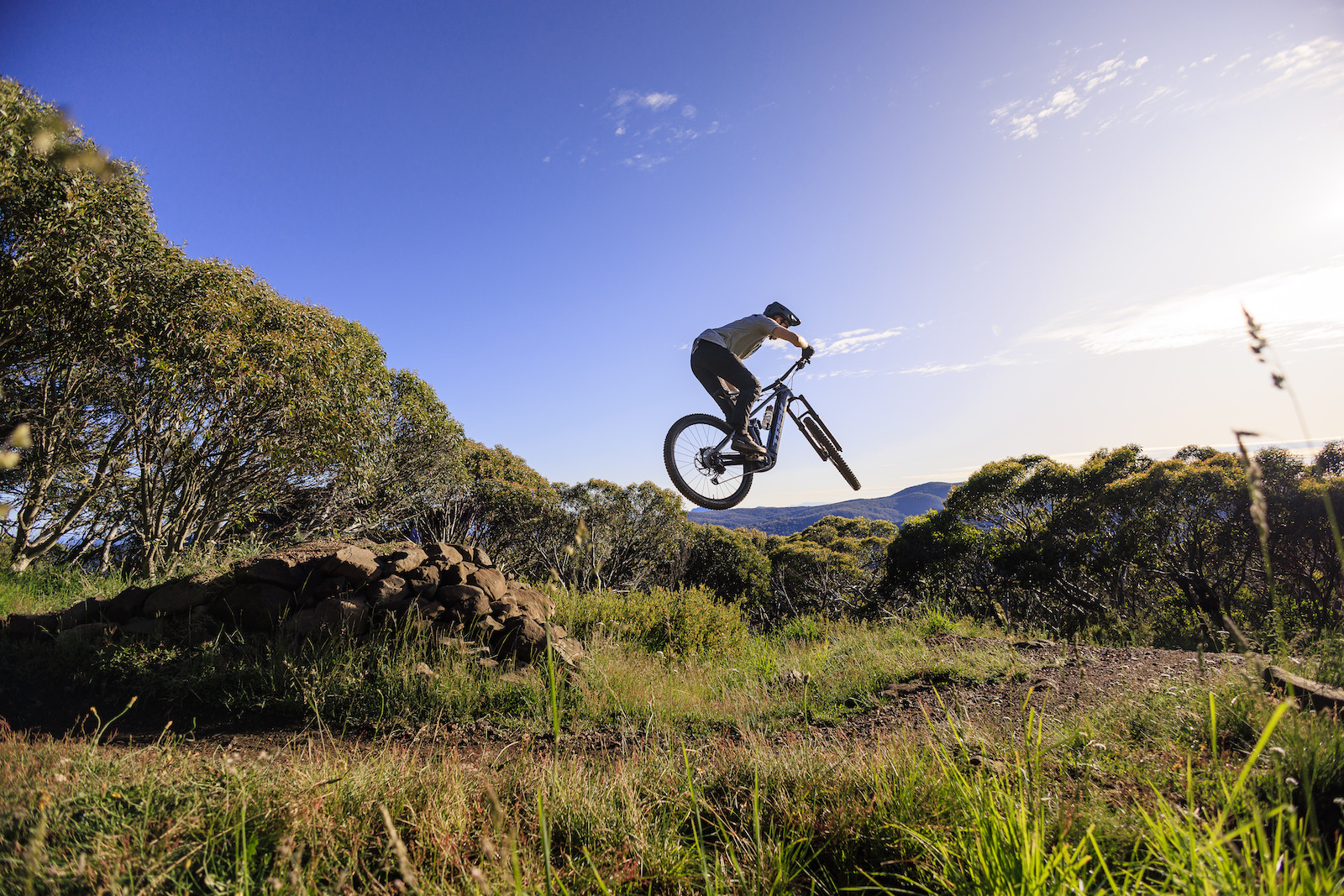
Testing the Trek Rail
In addition to testing the Trek Rail 9.8 XT on our home trails, this bike has accompanied us along some bigger alpine missions up at Mt Buller in Victoria’s High Country.
Buller has proven to be a terrific environment for a big and burly e-MTB like the Rail, with plenty of entertaining options for gaining elevation and some brilliant purpose-built descents to enjoy on the way back down. Tying it all together are epic views of the surrounding mountains, making this one of our favourite destinations to explore over the summer months.
To give it a proper workout, we took the Rail on a smorgasbord of backcountry singletrack around Buller including the recently refurbished Delatite River Trail, Clancy’s and the absolutely brilliant Stonefly. We also used the Rail to rack up plenty of self-shuttled laps of the gravity trails, including Outlaw and the classic ABOM.
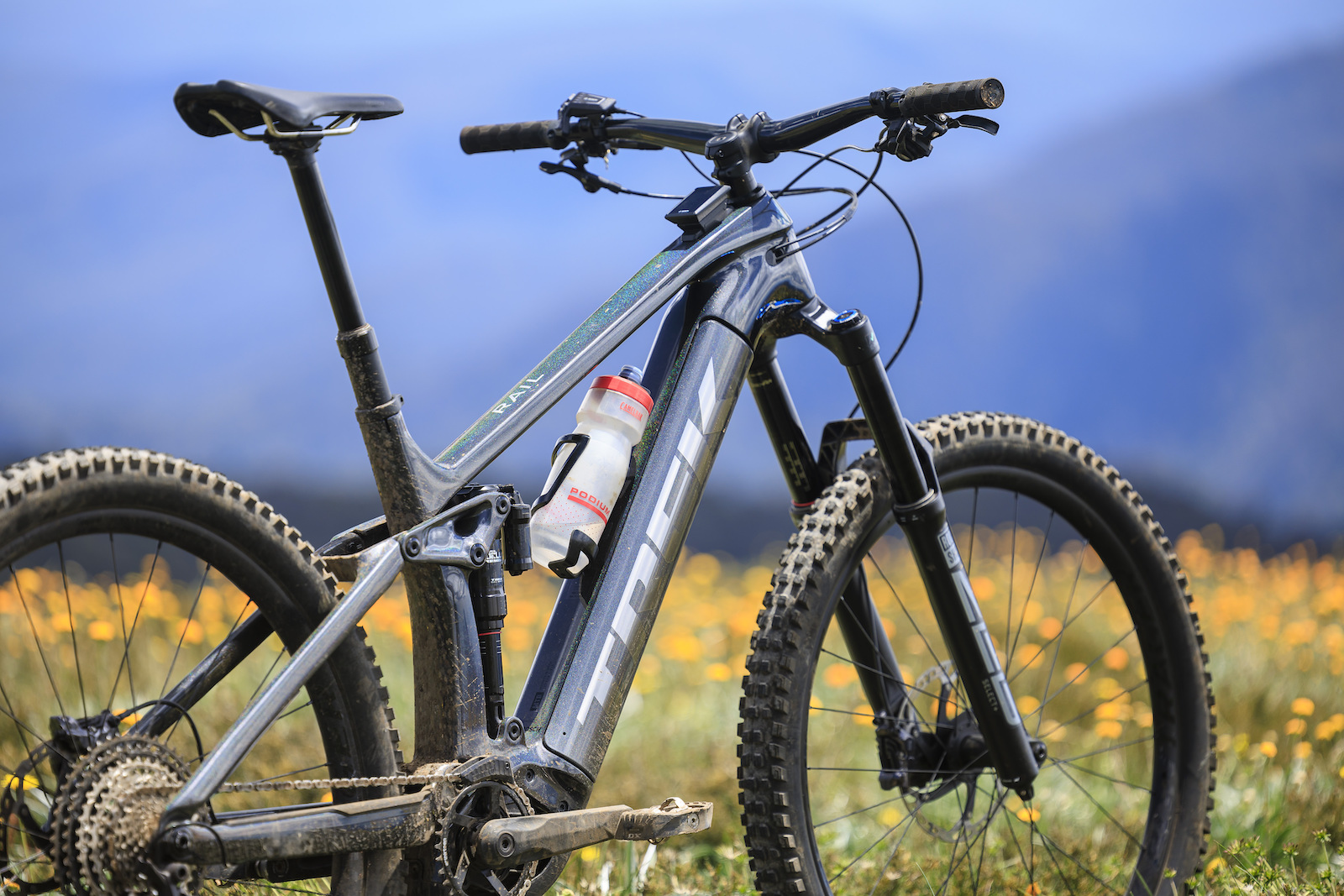
Trek Rail sizing & fit
While models like the Slash and Fuel EX are known for being offered in a huge range of sizes, the carbon Trek Rail models are currently only available in Medium, Large and X-Large sizes in Australia. We’re told that a Small will be arriving later this year, which will come fitted with a 625Wh battery to fit inside its shorter downtube. In the meantime, those after a Small will need to look towards the alloy Rail.
To suit the height of Dan (183cm) and Justin (180cm), we’ve been testing a Large. Compared to the previous model the reach has grown from 465mm to 487mm, which is a significant jump. The steeper seat angle does help to position the rider more centrally within the cockpit, though we reckon it could be a lick steeper since the effective top tube length on this bike is very long.
This presented more of an issue for Dan, who has shorter arms and prefers a more upright climbing position. To suit his proportions and riding style, Dan slid the saddle all the way forwards on the rails to steepen the effective seat angle and shorten the distance to the grips. Justin on the other hand had no such issues with the saddle in the middle of its adjustment range, and found the cockpit to be perfectly comfortable out of the box.
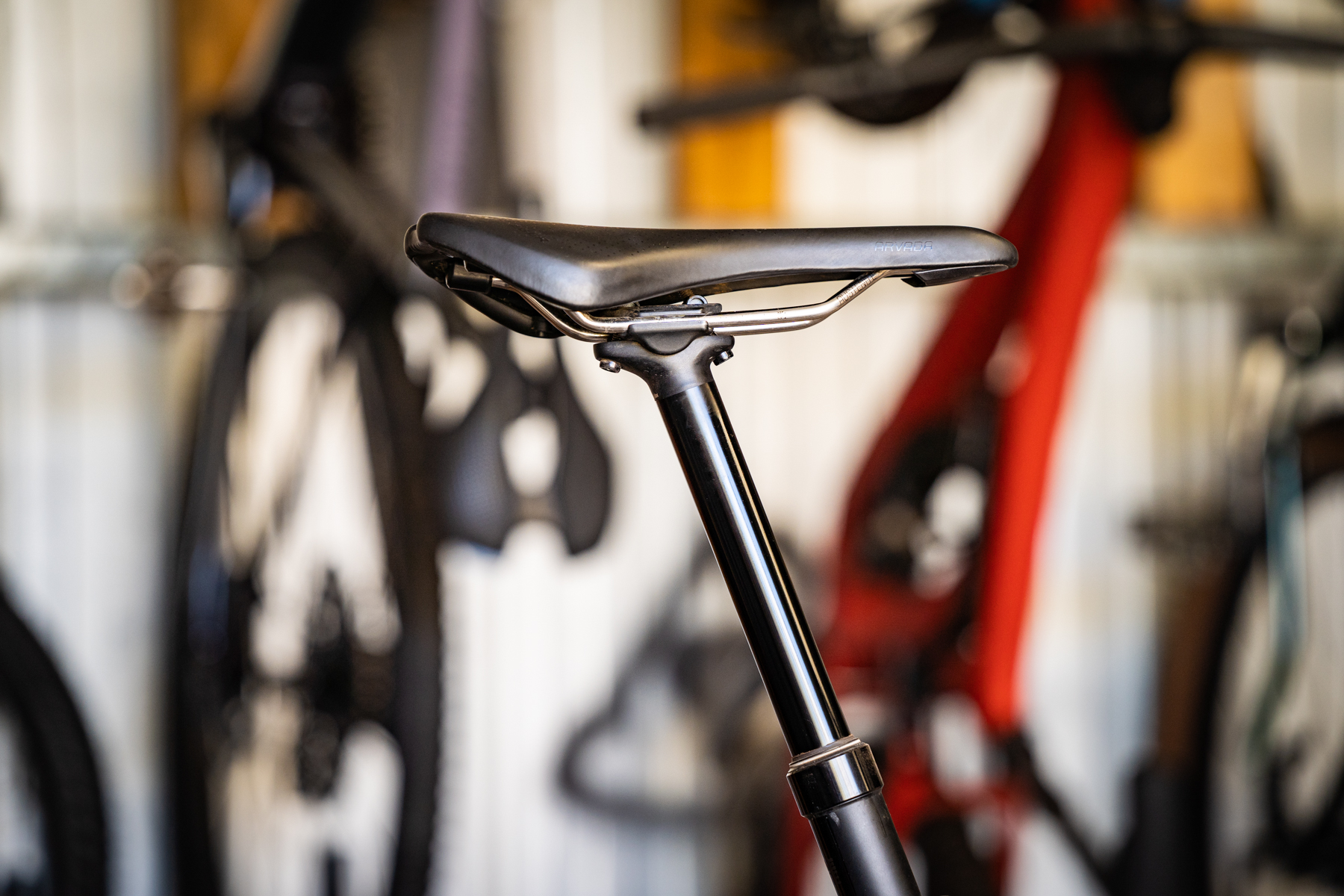
The takeaway from our experience? We’d recommend that anyone on the border between two sizes take a closer look at the geometry chart, as you may want to size down rather than up.
Even with the saddle shunted forwards, the Rail doesn’t suffer from a front-heavy riding position. That’s because the stack height is quite generous, coming in slightly taller than the old model. Combined with the well-proportioned bars, amenable grips and saddle, we’ve found it to be a comfortable bike during long exploratory missions out in the hills.
Suspension setup
Setting up the Rail’s suspension is made easy thanks to Trek’s online calculator, which is a fantastic tool for getting you started with air pressures and rebound settings.
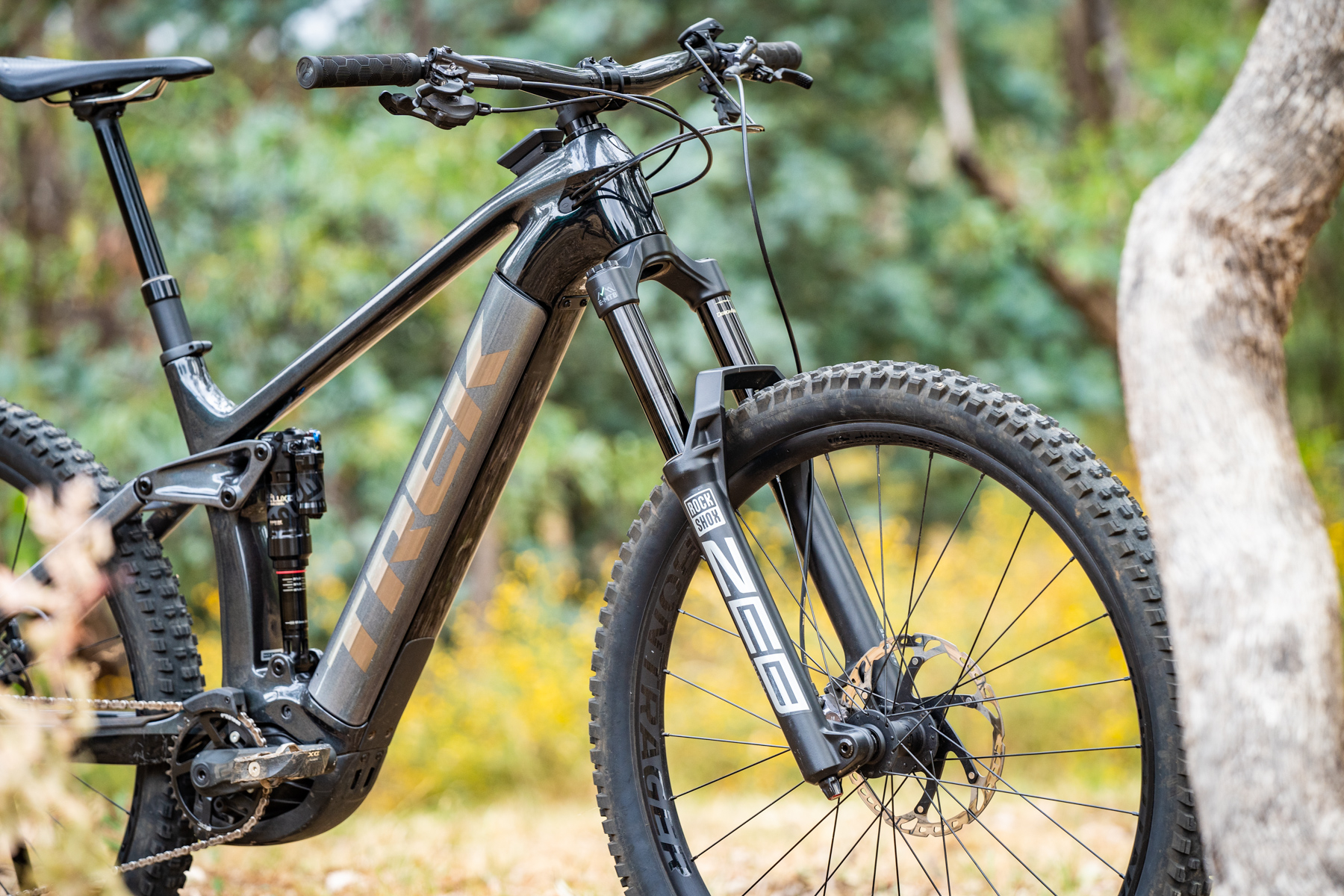
For Justin (85kg), the suggested settings proved to work well right off the bat. In comparison, Dan (83kg) made use of the recommended air pressures but trended towards a faster rebound setting to suit his more aggressive riding style.
There’s plenty of adjustment available with both the Zeb fork and Super Deluxe RT3 shock, which allows you to tweak the damping to suit different trail conditions. In particular, the 3-position compression dial on the rear shock makes a notable change to rear end grip and support, so we’d recommend experimenting with all three settings.
Once set up to preference, we didn’t need to touch the suspension at all throughout the test period. Bigger riders or those who are particularly heavy on their landings may want to fit an extra volume spacer in the rear shock to increase bottom-out support, but the stock setup will likely work well for most.
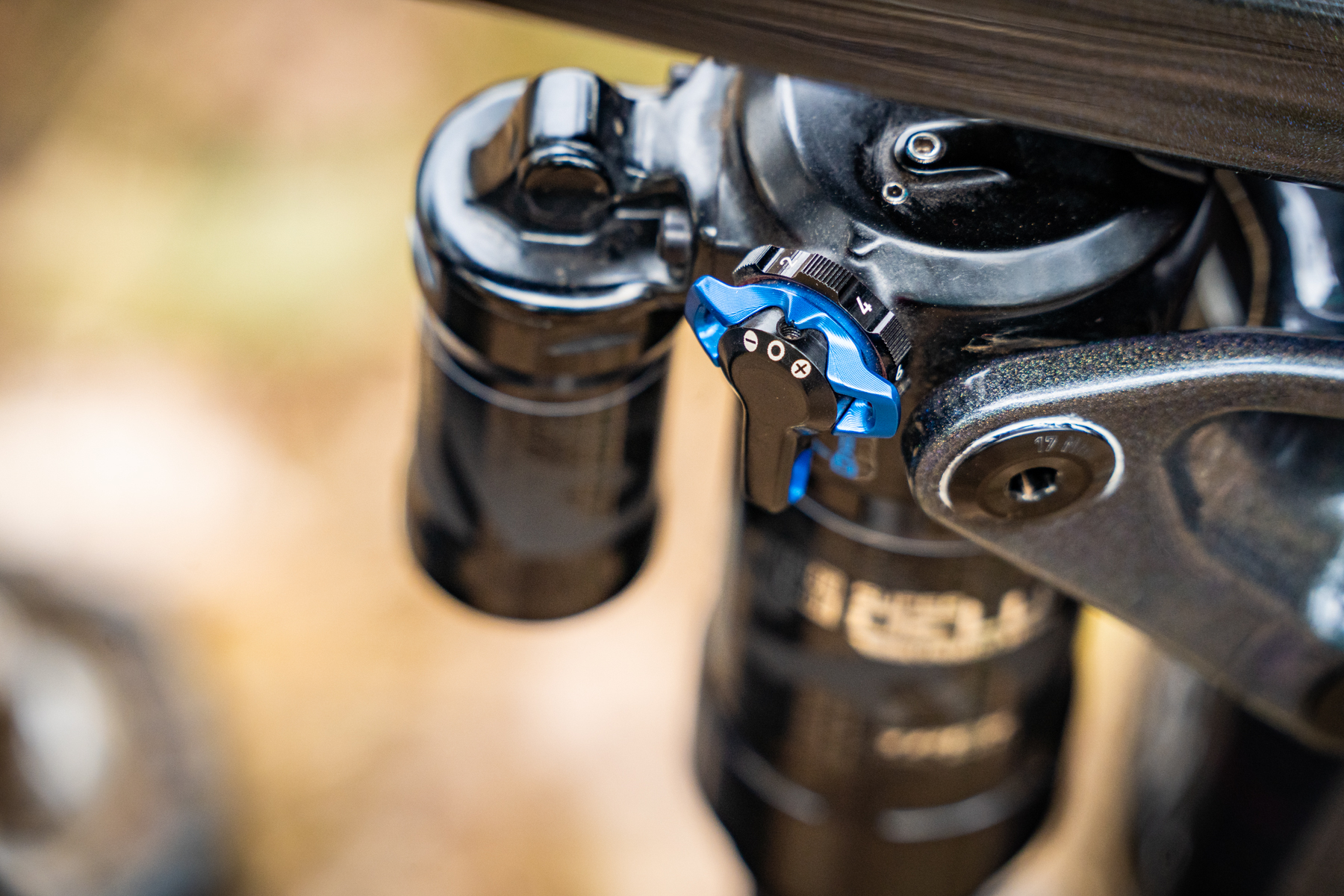
Trek Rail weight
Without pedals and with the tyres setup tubeless, our Trek Rail 9.8 XT test bike came in at 23.94kg.
That’s a little heavier than claimed, though it’s a reasonable figure for a big travel e-MTB with a 750Wh battery. If you’re particularly concerned about weight, you might want to look towards the mid-powered Trek Fuel EXe, which is over 5kg lighter.
Although the Bontrager SE6 and SE5 tyres use reinforced Core Strength casings, at just over a kilo each they’re significantly lighter than a full-blown DH tyre. Factoring in the abuse we’d likely be dishing out on the Rail, we fitted a CushCore Pro insert into the rear wheel to help ward off potential punctures and rim damage. Tyre pressures were set between 21-24psi up front, and 24-26psi out back.
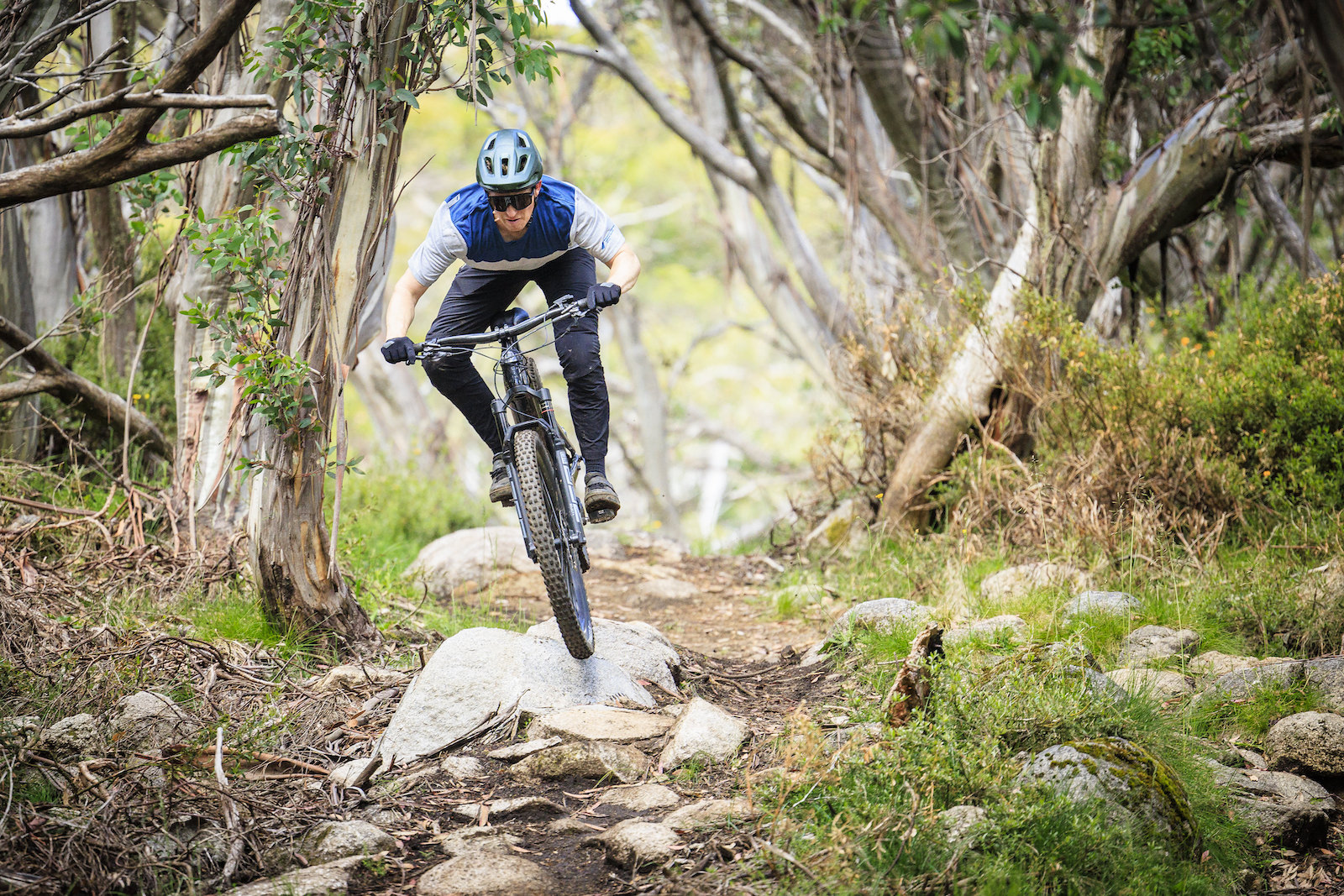
What do we dig about the Trek Rail?
As with previous models, we’ve been consistently impressed by the outstanding suspension performance on the new Trek Rail. This bike is beautifully balanced, offering great small-bump sensitivity while still delivering heaps of support. Along with the powerful brakes, aggressive tyres and long wheelbase, you can ride this bike bloody hard on some very rowdy terrain.
It has to be said that the Zeb is a perfect match for a burly bike like the Rail. An e-MTB is inherently more difficult to correct if you push it slightly off-line, with the added weight compounding any mistakes. The Zeb’s stiff 38mm chassis helps to keep the front wheel tracking where you want it, while the sensitive action soaks up off-camber impacts, maximising ground contact for increased grip.
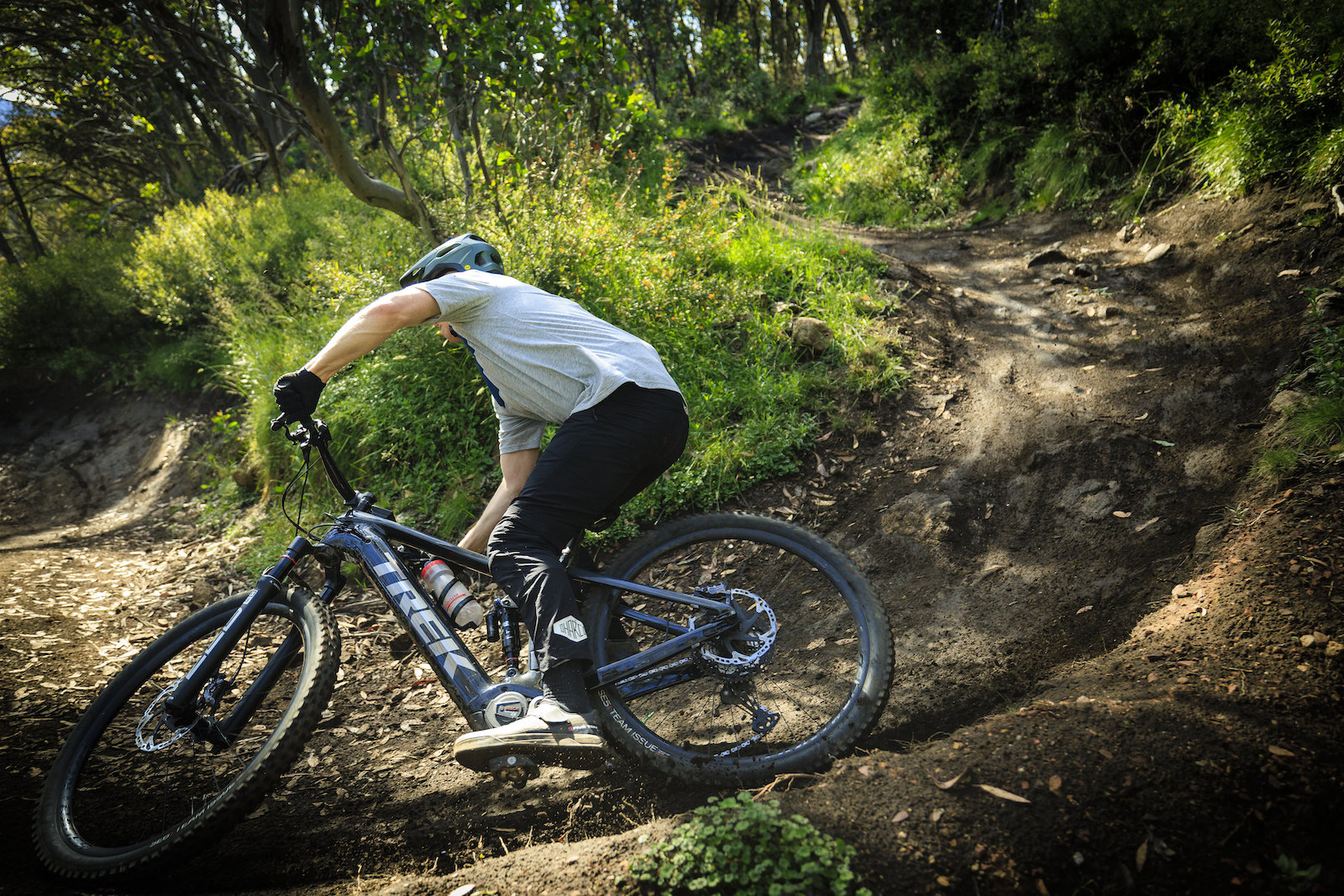
It’s a similar story out back with the custom Super Deluxe shock. Trek says the IFP-less design of the Thru Shaft damper reduces the ‘stick-slip’ effect when the shock is rapidly changing direction between compression and rebound, resulting in smoother and more responsive operation. Given how supple it is back there, it’s hard to argue with that claim.
Combined with the trunnion bearing mount and ABP linkage, the Rail delivers incredible sensitivity across a wide range of impacts and riding speeds. Traction and compliance are superb, with the shock recovering well on rapid-fire impacts. We never fully bottomed out the rear suspension, while the mid-stroke support means the Rail has surprisingly good pep on flowier jump trails. The fact that it ‘only’ has 150mm of rear travel means it doesn’t totally numb the trails like a longer travel e-MTB would.
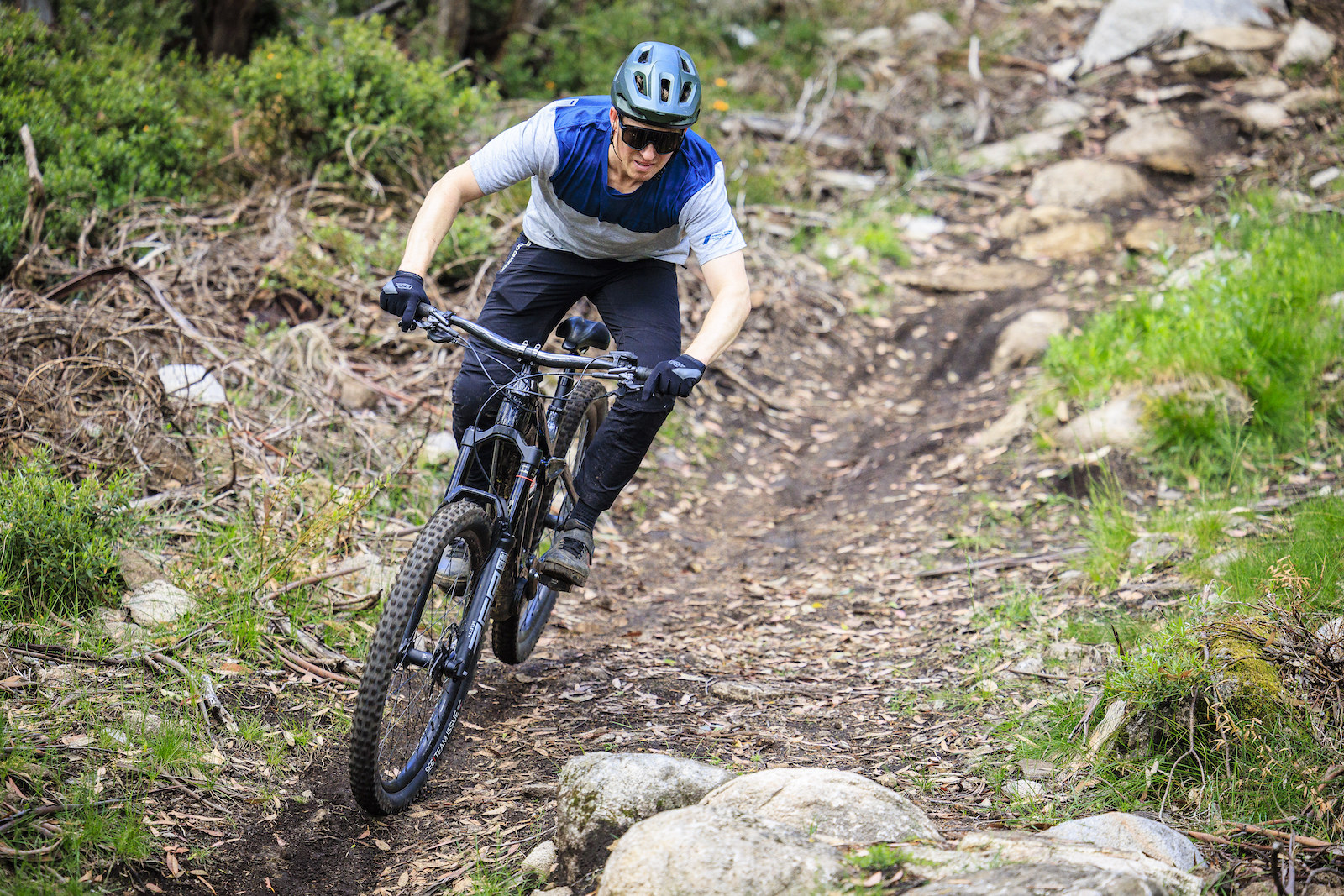
Stout frame & responsive handling
Enhancing the Rail’s enthusiastic on-trail demeanour is its stiff carbon frame, which feels noticeably sturdier and more responsive than previous iterations. Paired to the Zeb up front, the handling is direct and surefooted.
Much like the Canyon Spectral:ON, that chassis stiffness never results in untoward harshness. Indeed the supple suspension, high volume tyres and alloy rims ensure the Rail contours the terrain rather than pin-balling you around.
The short rear end also contributes to the responsive handling, helping to make the Rail feel manageable despite its heft. While a longer rear centre can improve high-speed stability, it tends to make the bike more sluggish and harder to leave the ground. Trek has avoided that sensation with the Rail, with its short chainstays providing a welcome dose of agility. It rips corners confidently, and thanks to the supportive suspension, it’s also more than happy to take to the air.
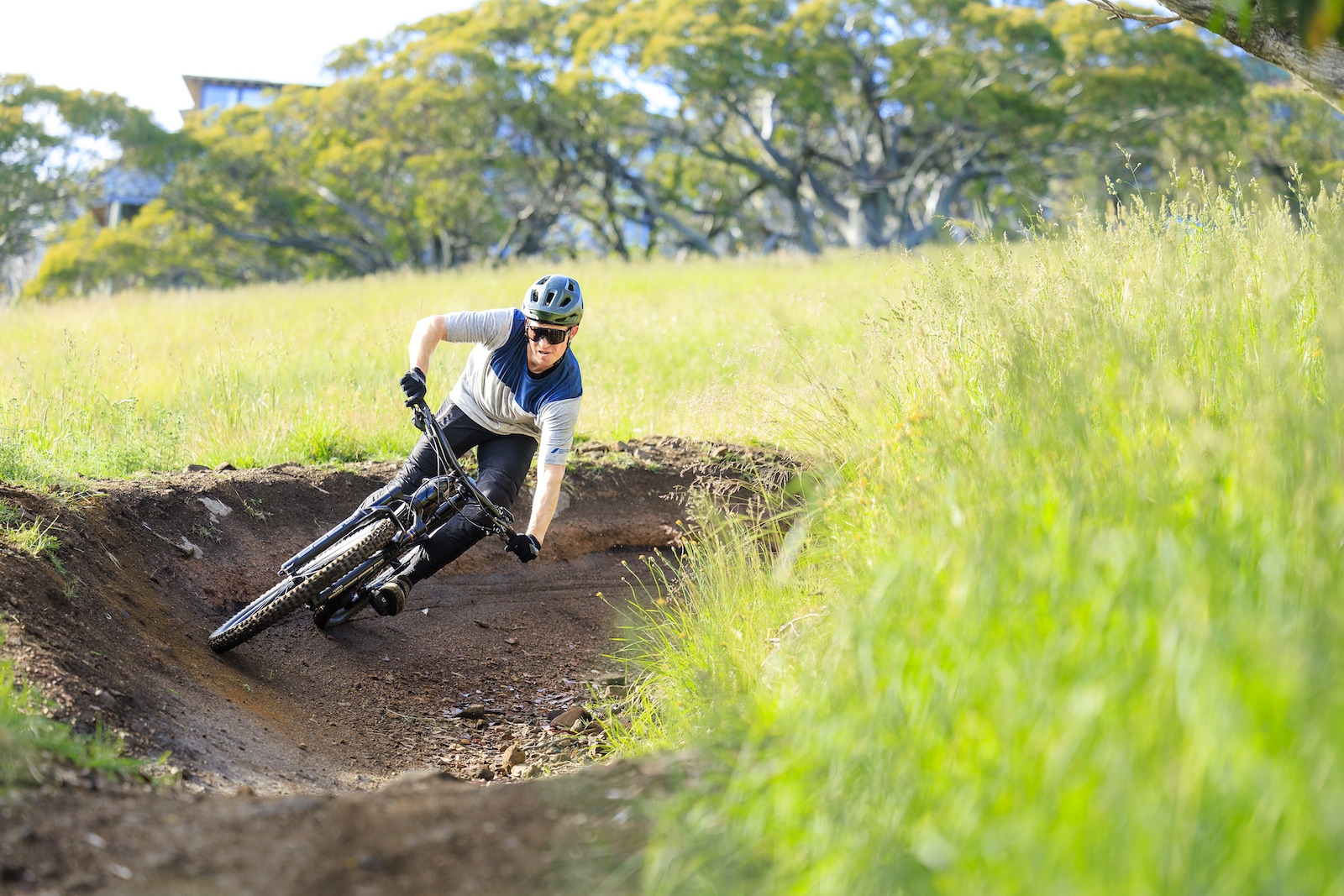
Bosch power & control
Along with its supple suspension and sturdy chassis, the Bosch Performance CX Line motor is another key component to the Trek Rail’s all-round performance. In our experience, this is the best full-powered motor out there.
Set to the adaptive eMTB mode, power delivery is responsive and intuitive. There’s plenty of low-range torque on tap, and the overrun feature means power continues to be applied even if you need to briefly coast over roots and rock ledges on a technical climb.
It’s particularly advantageous for larger-sized riders, with the Bosch motor providing masses of support and powerful acceleration. For lighter riders, bumping the assistance mode down to Tour+ will still provide that intuitively adaptive power output, albeit with a less abrasive punch and a milder overrun.
If you’re willing to make use of the lower powered settings, it’s possible to eke out some serious mileage. Indeed with the big 750Wh battery, you’re unlikely to experience any range anxiety with the Rail. This bike offers proper long-range potential, making it a fantastic option for huge e-MTB adventures out in the mountains.
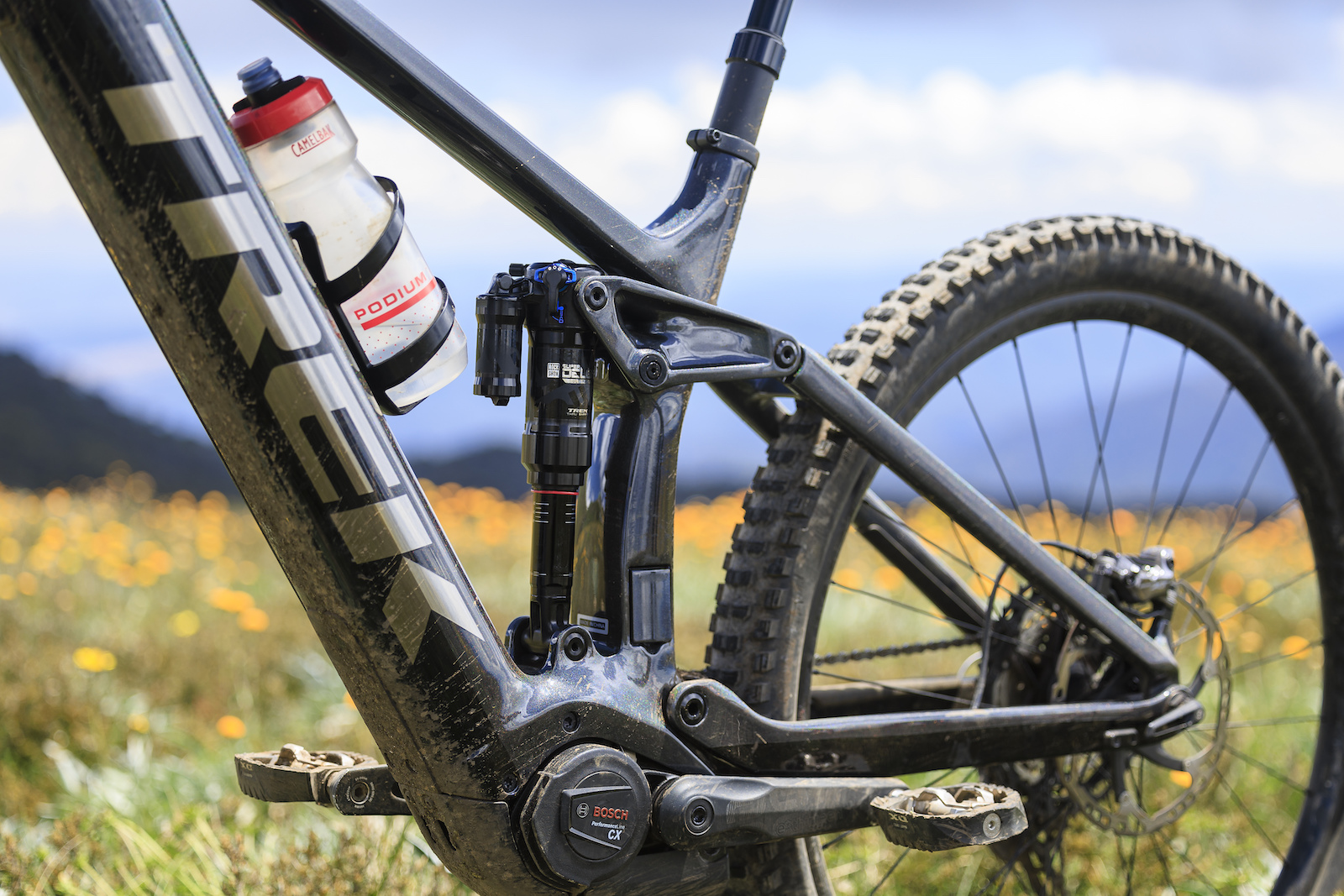
While it will happily cruise along, the Rail also enjoys climbing fast and aggressively. Despite not having enormous chainstays, it’s still very calm and composed on steeper gradients. There’s little wander from the front wheel, with the long wheelbase and active suspension keeping the whole bike glued to the ground.
We didn’t encounter an excessive number of pedal strikes, though switching the shock’s compression dial into the firmer position does lift the ride height noticeably. Furthermore, flipping the Mino Link into the High position will garner you an additional 5mm of pedal clearance, while sharpening the seat angle and shifting more weight onto the front wheel. This will be useful for more active riders, and those who are scaling chunky climbs and eroded gullies.
The only real limiting factor on the climbs is the rear tyre, which didn’t have as much bite as we wanted. The tread profile is a little too shallow, and it lacked grip when the conditions were wet. We’d consider fitting an SE6 on the rear, which would offer more predictable traction on loose and slippery terrain.
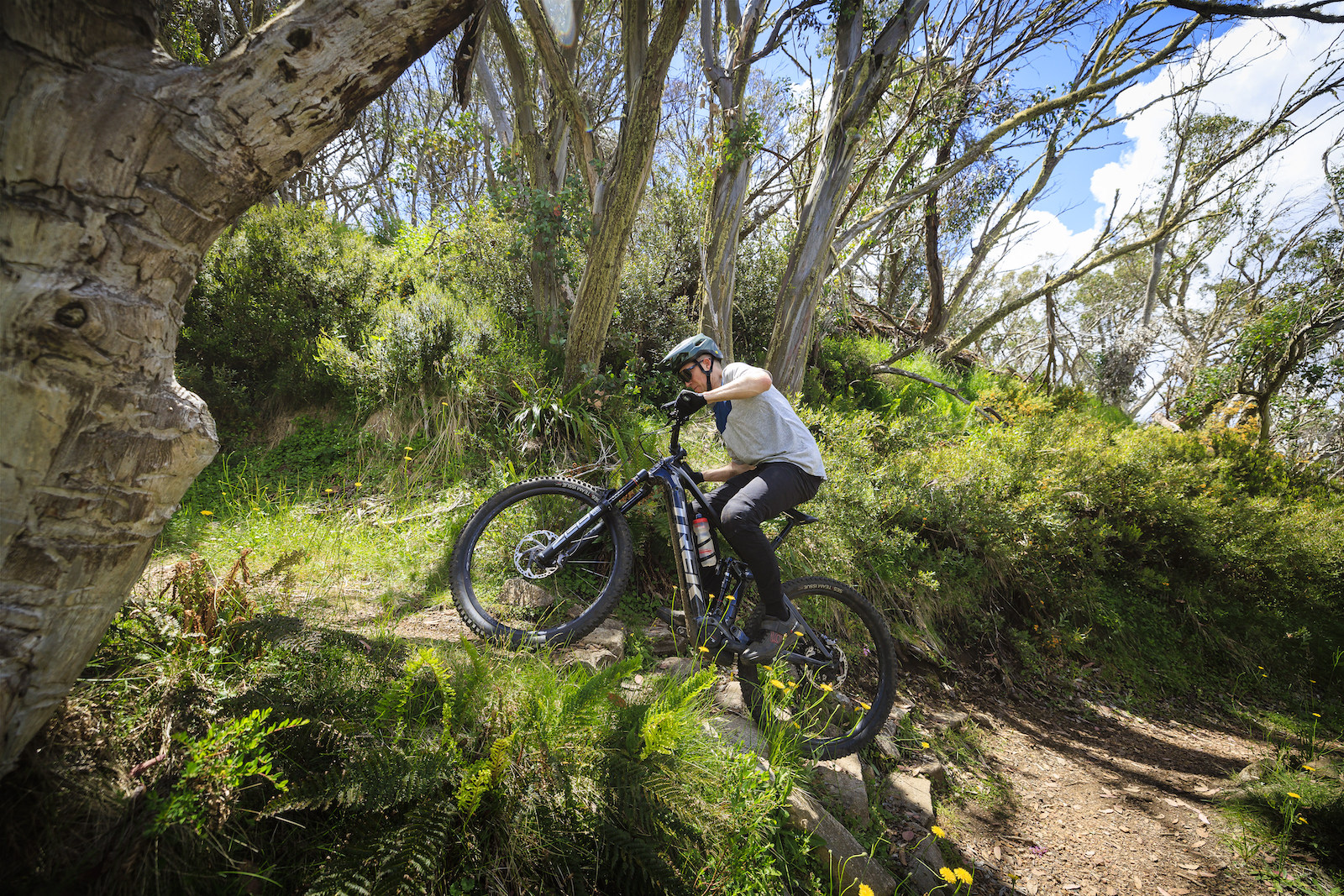
What don’t we like?
As with the previous Trek Rail 9 we tested, we encountered a few annoying issues with our Rail 9.8 XT.
Most disconcerting was the battery rattling around in the frame. After a dozen or so rides we noticed a heavy clunking sensation on the descents that felt a bit like a poorly-adjusted headset. This turned out to be from the upper battery mount, which had come loose from where it bolts into the downtube. While the battery was still able to provide power to the motor, it meant the whole assembly was rattling around inside the frame. Not ideal.
This is of course a disappointing experience to have on a bike costing over $12K.
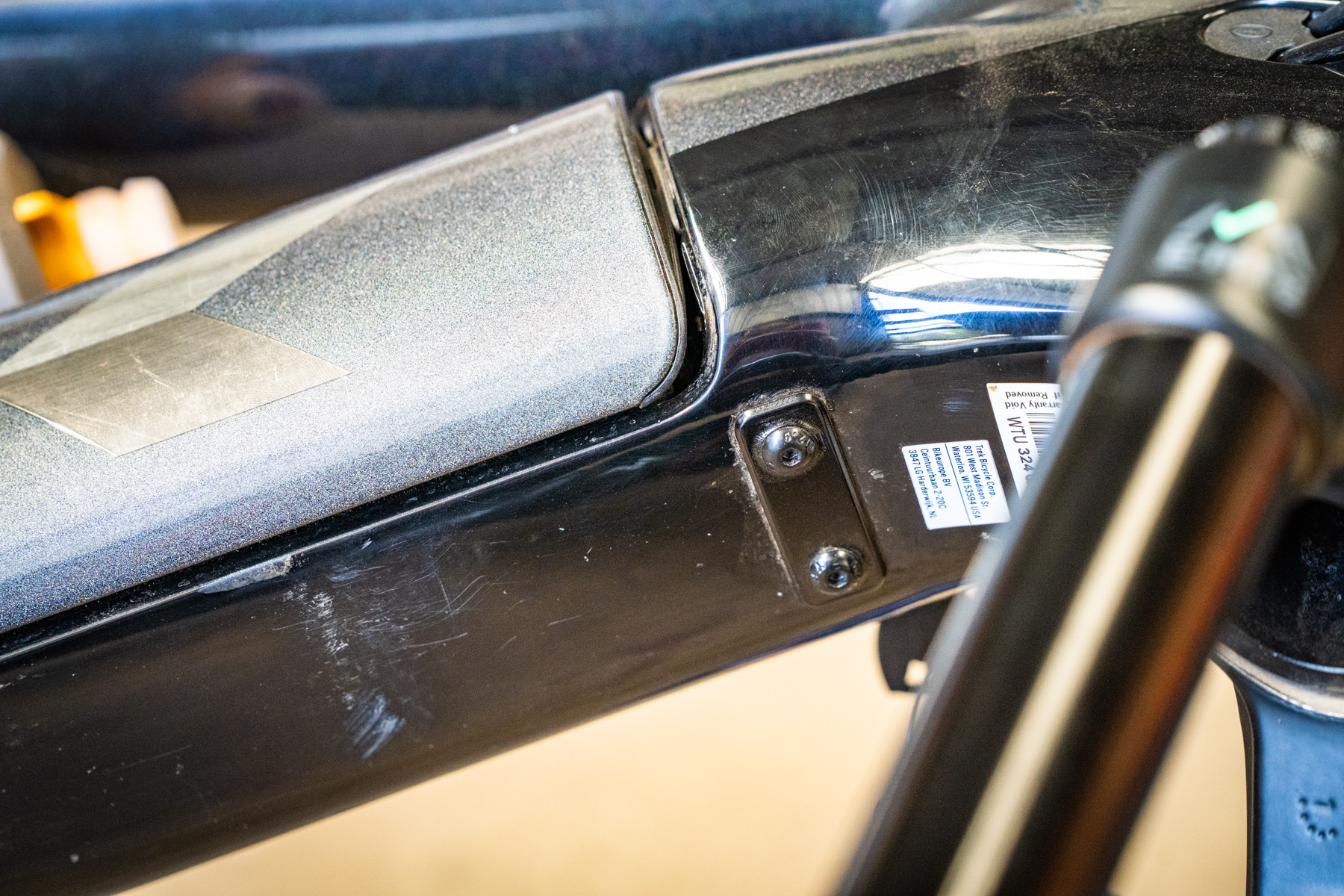
Our local Trek dealer put in a warranty claim, and within a couple of days we received a solution. This comprised of a small metal bracket that sits on the outside of the downtube, with two bolts passing through it to secure the internal battery mount to the frame. The bracket did the job, and has eliminated the clunking sensation on the descents.
This is of course a disappointing experience to have on a bike costing over $12K. Having to spoken to other Trek dealers, it appears that we’re not the only ones to have encountered this issue, which leaves us wondering why bikes are being sold without the bracket in the first place.
Even after the fix, the Rail hasn’t been totally quiet. The Bosch motor exhibits the usual clacking noise on the descents, though we found it pretty easy to ignore after the first few rides. One of the Mino Link bolts and the main pivot came loose partway through testing, which required some fresh Loctite and a torque wrench to keep them snug. The rear thru-axle has also come loose on two occasions, so we’d recommend checking it regularly to make sure it remains nice and tight.
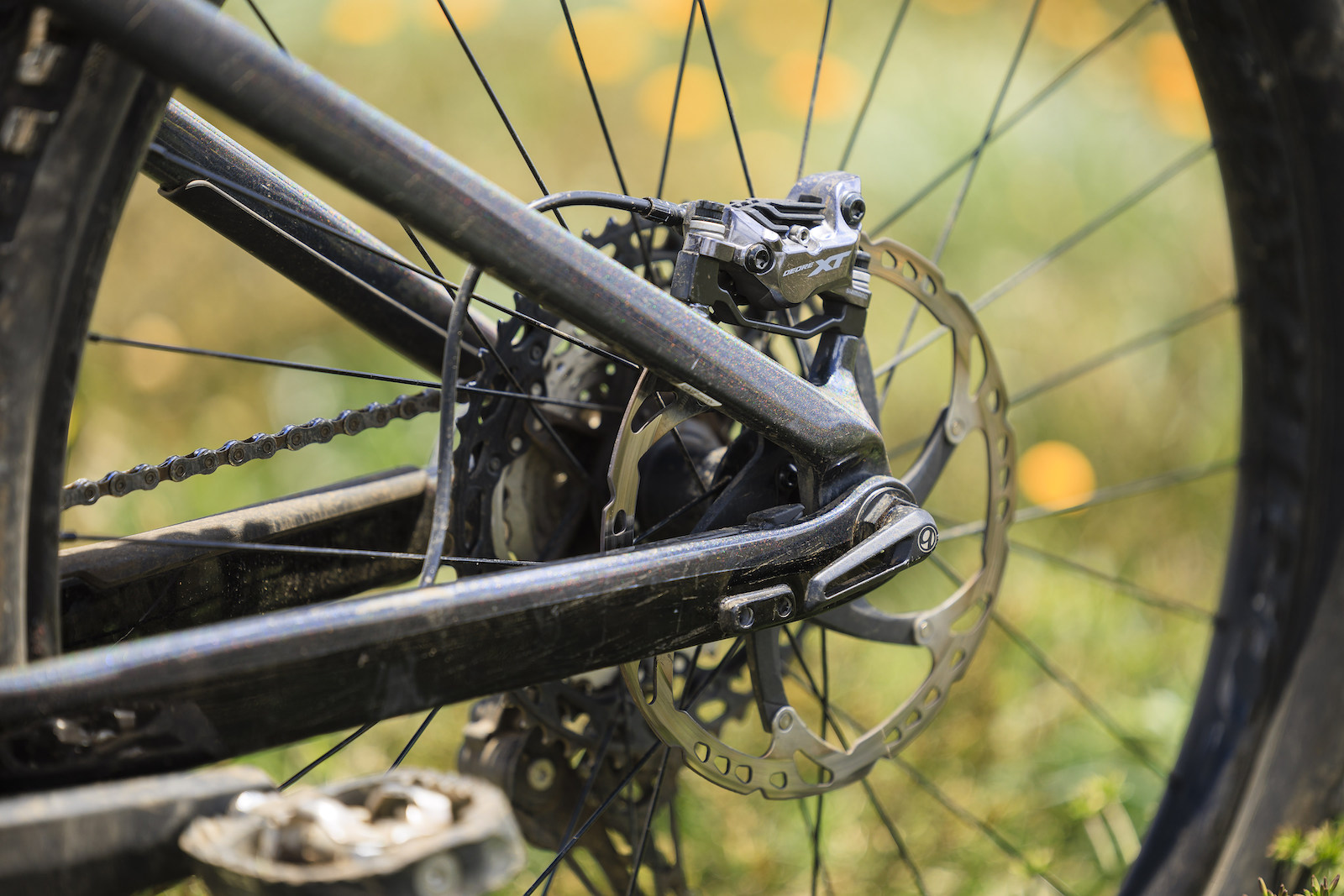
It can be a bit of a tank
While the Trek Rail is a mostly well-balanced bike, it has to be said that riding across flatter and more mellow terrain is not its raison d’etre. Its long wheelbase and overall heft can make it a handful on tight and flat turns, which require some muscling to negotiate.
The short chainstays mean it isn’t a total barge, but compared to the previous version it does require a more forward-biased riding position. This sees it rewarding a more active and assertive rider, especially when you’re threading the front wheel through twistier singletrack.
For smaller folks and those who are newer to the sport however, the Rail can feel like a bit of a tank. If you’re looking for a less brutish riding experience, you might want to consider the lighter and lower-powered Fuel EXe or perhaps even an alloy Rail that features less stretched-out geometry.

Now while it is a lot of bike to manage, we should point out that for a full-powered e-MTB with dual 29in wheels, the Rail is arguably one of the best-handling bikes in its category. It’s certainly far more fun and involving to ride than the Scott Patron, despite being more capable overall.
It is less agile than the Specialized Levo however, which shares the same amount of travel but packages it into a dedicated mullet platform with a 27.5in rear wheel. Of course it is possible to fit a 27.5in wheel to the back of the Rail, which would be a great option for riders looking for a more playful character and a little extra tyre-to-arse clearance. If you do decide to go down that route, you can take your Rail into a Trek dealer to have the Bosch system reconfigured for the smaller wheel circumference, which will maintain the proper speed reading and motor output.
It’s worth noting that even with the Mino Link in the High position, a mullet setup would result in a lower BB. With that in mind, it may be worth considering fitting a 170mm airshaft to the Zeb, since the Rail’s frame is rated for it. This would lift the ride height and slacken out the head angle further, turning the Rail into a more gravity-focussed machine.
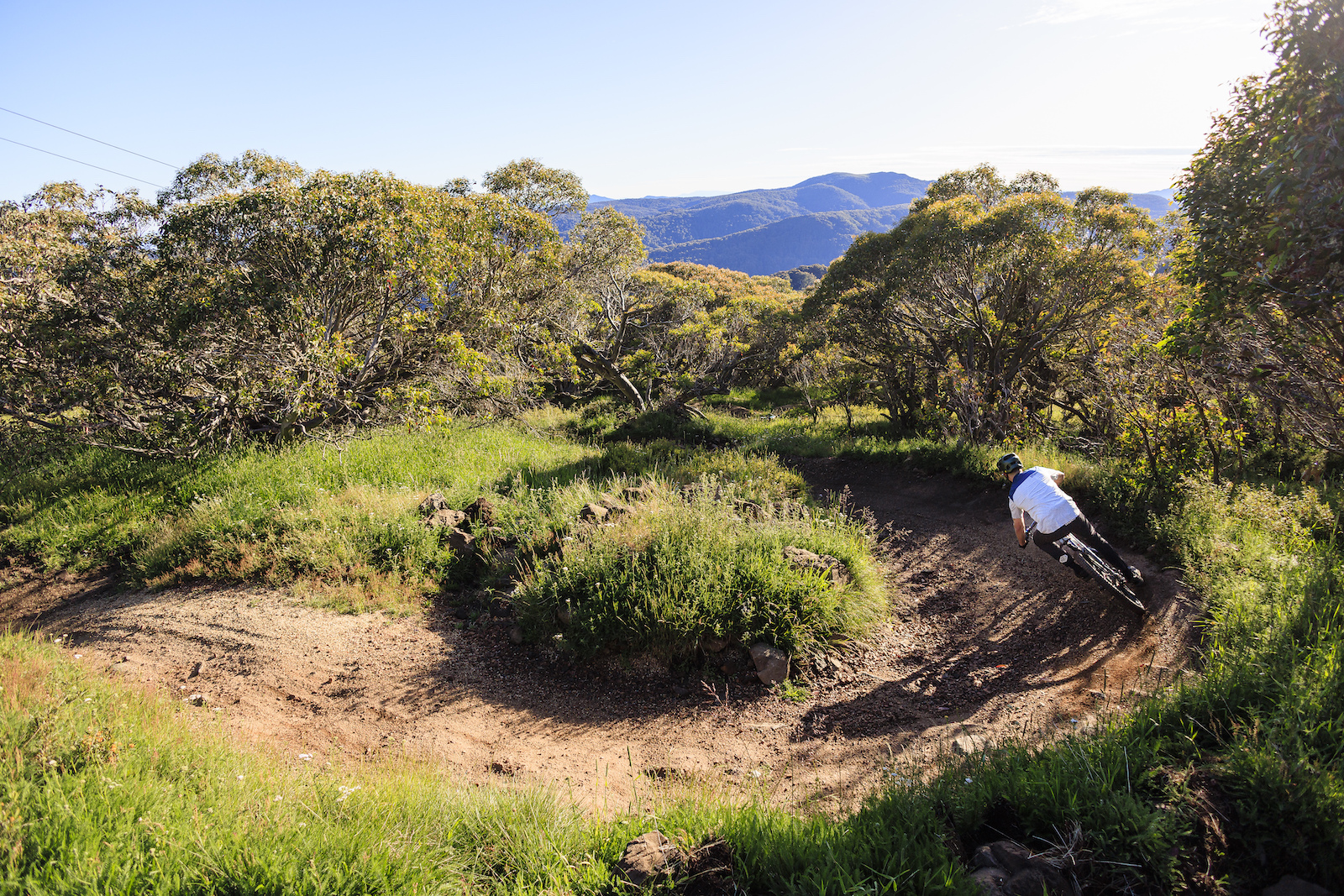
Component highs & lows
When it comes to the price to performance ratio, there’s no doubt that the Trek Rail 9.8 XT hits the sweet spot in the range.
The suspension is top-notch and offers plenty of usable adjustability. The Zeb’s Charger 2.1 RC damper is excellent, and really doesn’t give up a whole lot compared to the pricier Ultimate version. The Thru Shaft shock is brilliant, and it’s a big reason why the Rail is so plush and controlled.
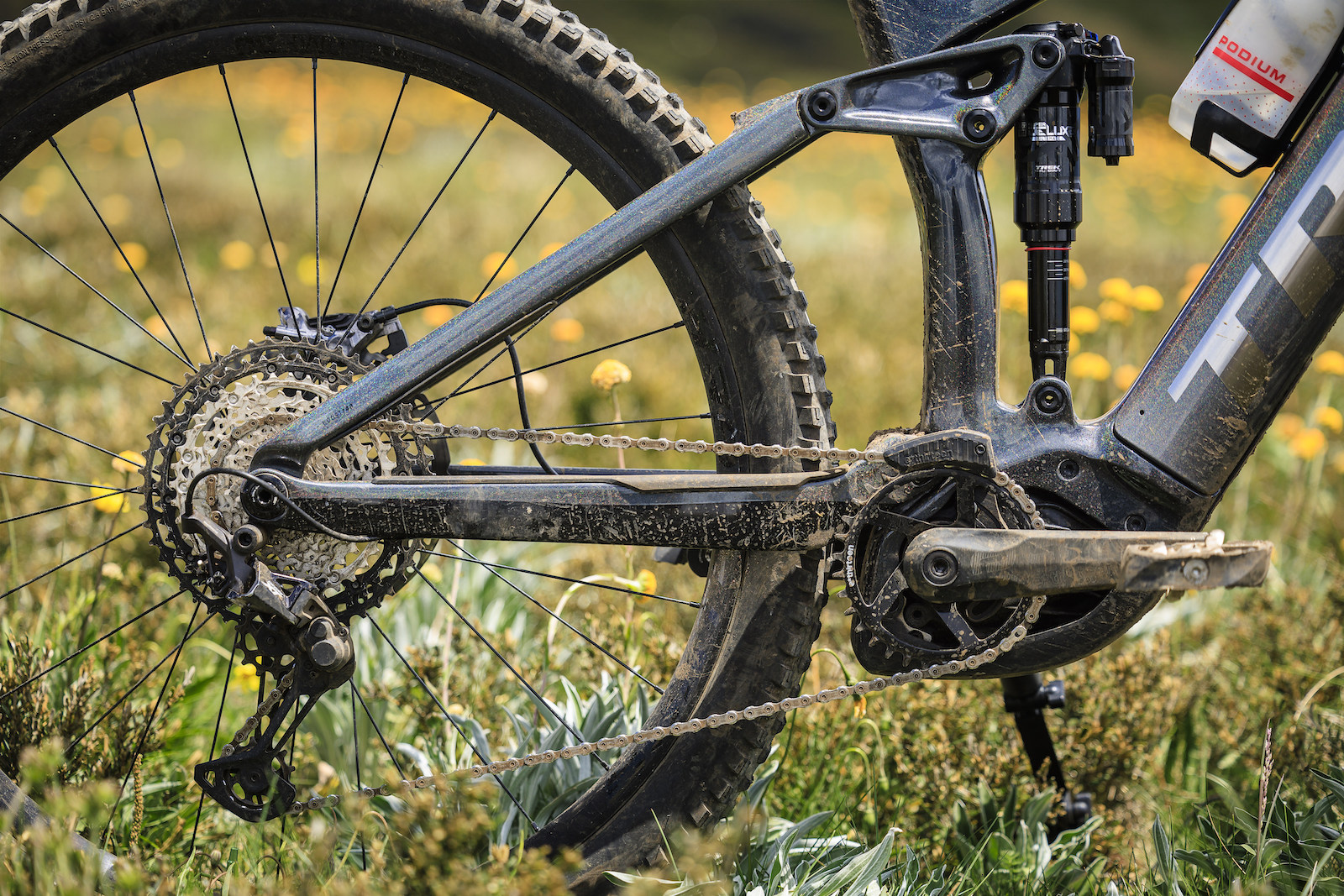
The Shimano XT groupset is solid, and we’re glad to see a genuine Shimano 12-speed chain when other brands have been skimping and fitting a KMC chain instead. Unfortunately a freak encounter with a rock that got jammed in the chainring caused the chain to break while Justin was partway through a Stonefly mission. A spare link rescued the day, though once back in the workshop we had to replace both the chain and chainring. It was a timely reminder that stuff gets absolutely hammered on an e-MTB, and having a fancy XTR or AXS drivetrain might not be the most practical approach.
We did bleed the brakes partway through testing, as the rear was feeling slightly spongey. Thankfully it’s a quick and easy process to do with Shimano brakes, and we didn’t need to touch them for the remainder of the test period. While heavier riders will benefit from fitting a 220mm rotor up front, we found the stock setup to be plenty powerful.
Given the bush-bashing you can do aboard the Rail, we’ve been happy to have alloy crank arms and rims. Bontrager’s Line Comp wheels have been absolutely solid throughout testing, with no loose spokes, rim dings or freehub pops to speak of.
We’ve also managed to come out the other side with zero punctures or sidewall tears, which is quite frankly, amazing. The stock tyres will perform well in most Australian conditions, though if this were our bike, we’d put the SE6 on the rear to increase climbing grip and cornering traction on loose surfaces. We’d then fit a stickier compound tyre up front, like a Maxxis Assegai 3C MaxxGrip, a Specialized Butcher T9 or a Continental Argotal Super Soft DH tyre.
As far as touch points go, the LED controller is functional, but the way it sits up above the bar makes it somewhat vulnerable in the event of a crash. The Kiox 300 display is nicely tucked out of the way though, with a vibrant screen that provides you with access to loads of data without being too distracting for the rider. Still, we’re glad to see Trek update the Rail for 2023 with the newer System Controller and Mini Remote for a more discreet user interface.
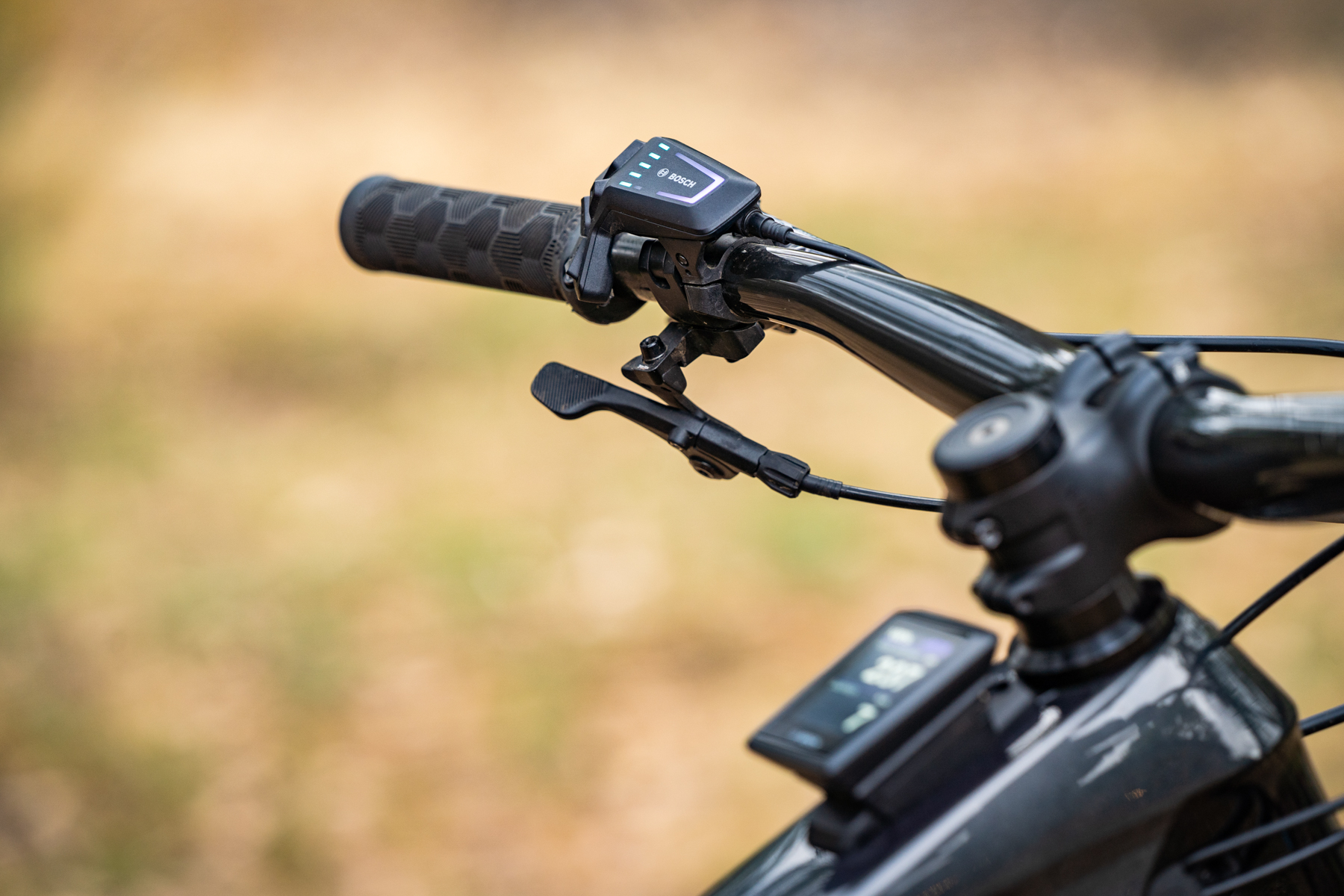
What about the alloy Rail?
If you didn’t quite have the budget to stretch to the Rail 9.8 XT, the alloy Rail 9 is definitely worth consideration. It features the same suspension package, wheels and tyres, and it still gets a Bosch Performance Line CX motor. It’s equipped with a smaller 625Wh battery though, and it uses the slightly older generation frame with a shorter reach and slacker seat angle. That’s not necessarily a bad thing, as we found it to be a slightly more agile bike due to the shorter wheelbase, which will potentially be preferable for less experienced riders.
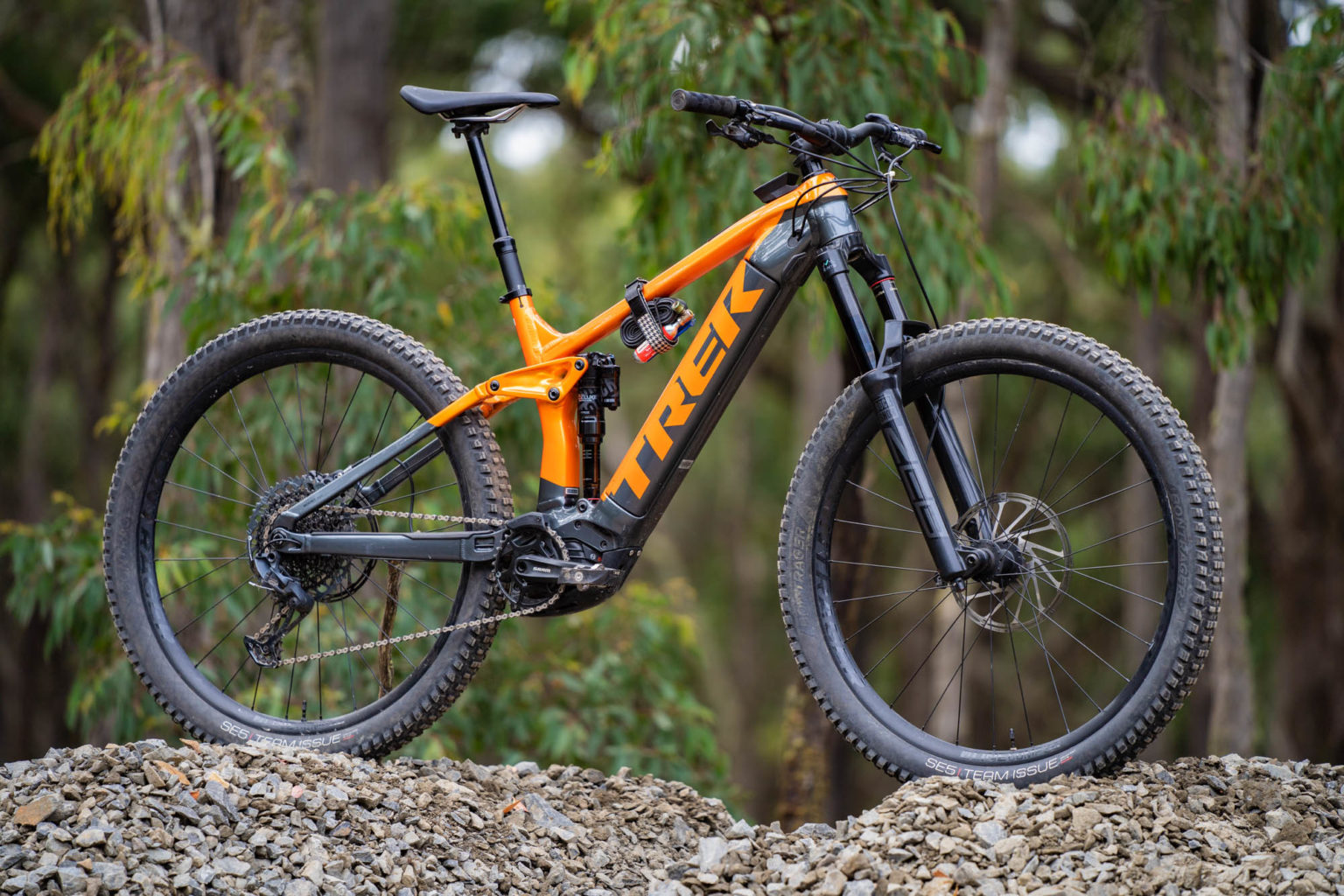
Trek Rail vs Norco Sight VLT
Speaking of comparisons, a bike that we’ve spent a load of time on is the Norco Sight VLT, which is another thoroughly popular e-MTB in Australia.
Like the Rail, the Sight VLT features 160/150mm of travel and is built around 29in wheels. It’s also available with an alloy or carbon frame, though Norco has equipped it with a Shimano EP8 motor and a custom battery that’s available in 500, 720 and 900Wh sizes.

The spec you get for the money is notably better with the Sight VLT. With a 720Wh battery, the top-end Norco Sight VLT C1 sells for $12,899 AUD. That’s a similar price to the Rail 9.8 XT, but the Norco’s spec is significantly more desirable with Fox Factory Series suspension, SRAM Code RSC brakes, a OneUp dropper, DT Swiss wheelset and Maxxis DoubleDown tyres as standard with a 3C MaxxGrip Assegai on the front.
Spec aside, these two bikes do produce quite a different ride experience on the trail.
The Sight VLT feels like a bigger, heavier and less refined e-MTB. This sensation was accentuated on the bike we tested, which came fitted with a 900Wh battery that weighs half a kilo more than the Rail’s 750Wh battery. However, it’s really the Sight VLT’s longer rear centre (462mm vs 448mm) that makes the biggest difference in terms of handling.
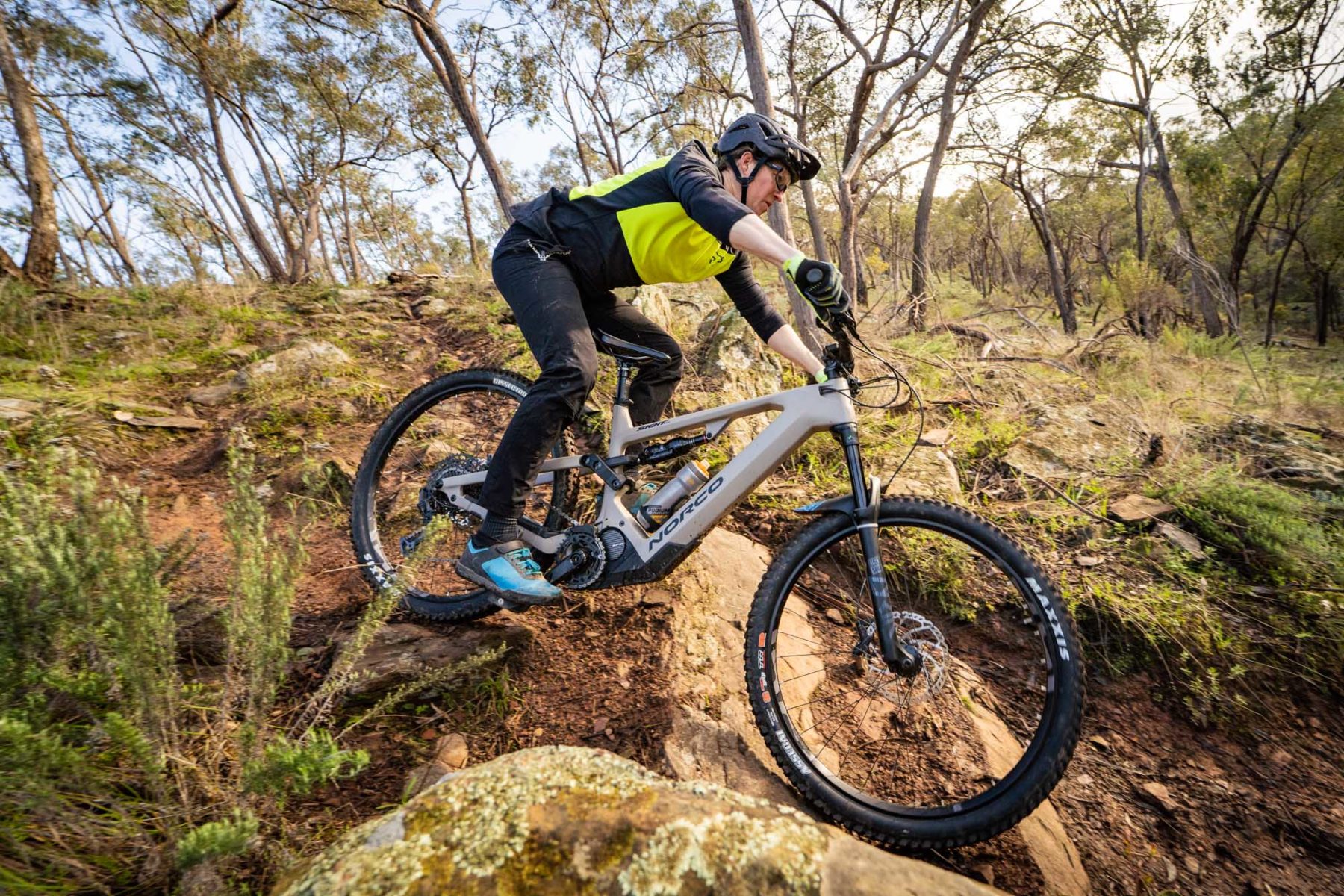
The longer wheelbase does make the Sight VLT incredibly stable, and we found it would happily plough its way downhill with a plush and bottomless feel to its rear suspension. However, it’s not as responsive as the Rail. It’s noticeably harder to change direction, with a cumbersome feel through the corners and across tighter trails. It’s also much more difficult to lift up the front wheel when launching off a drop or manualling down the trail.
The long chainstays and steep seat tube angle makes the Sight VLT a very planted bike on the climbs. Unfortunately the Shimano EP8 motor doesn’t produce the same power or overrun as the Rail’s excellent Bosch motor, resulting in slower climbing speeds and less assistance on technical stop-start features. The Rail pulls further ahead on tight switchback climbs, with its shorter chainstays allowing it to pivot around with more precision.
While both bikes are great examples of a modern full-powered e-MTB, the Rail edges out the Sight VLT when it comes to suspension performance and all-round handling. Whether it’s worth the price premium depends on how much value you place on its ride quality, Bosch system and Trek’s warranty support.
Trek Rail vs Trek Fuel EXe
Of course the competition for the Trek Rail isn’t just coming from other brands. With the recent introduction of the Fuel EXe, Trek now has an alternative choice in its e-MTB lineup.
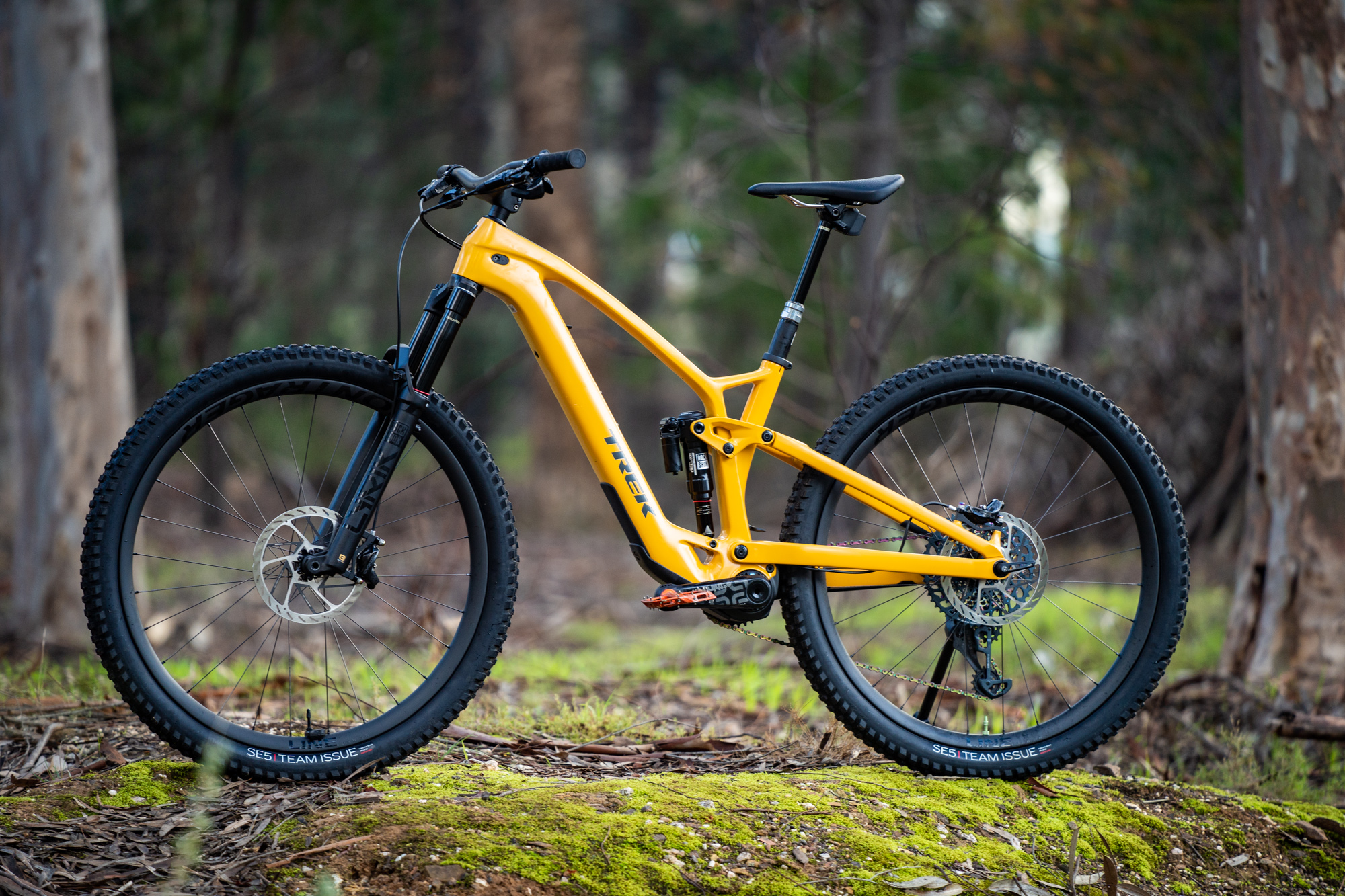
Compared to the Rail with its 85Nm motor and 750Wh battery, the Fuel EXe takes a sleeker and lighter-weight approach. It’s built around a tiny TQ motor that puts out 50Nm of peak torque, and it uses a much smaller 360Wh battery. Along with its slimmer frame construction, it weighs in at just 18kg for the complete bike.
The Fuel EXe does have less travel with a 150mm fork and 140mm at the rear. However, the frame will accommodate a 160mm travel fork, which is exactly how we set it up for our long-term Fuel EXe review. Along with stickier tyres and a few other changes, the Fuel EXe is an incredibly capable and fun e-MTB to ride.
Comparing the two bikes, it’s obvious that the Fuel EXe’s suspension isn’t as plush as it is on the Rail. The extra 10mm of travel and the custom Thru Shaft shock gives the Rail hypersensitive performance that delivers more grip and more comfort when things get choppy. Along with the slacker geometry and added weight, it’s a more planted bike at speed, especially when full-gassing it on hectic DH trails.
When things get tight and twisty however, the lighter Fuel EXe offers greater agility. It’s easier to ride, with more intuitive and involving handling that doesn’t make you feel like you’re an unwilling passenger. The lower weight is instantly noticeable on the trail, allowing you to change direction with less effort. It’s just also easier to deal with on a practical day-to-day basis, like when you need to flip it over to repair a puncture or load it onto a bike rack on the car. Combined with its softer and whisper-quiet motor output, it’s a less intimidating bike for newer riders.
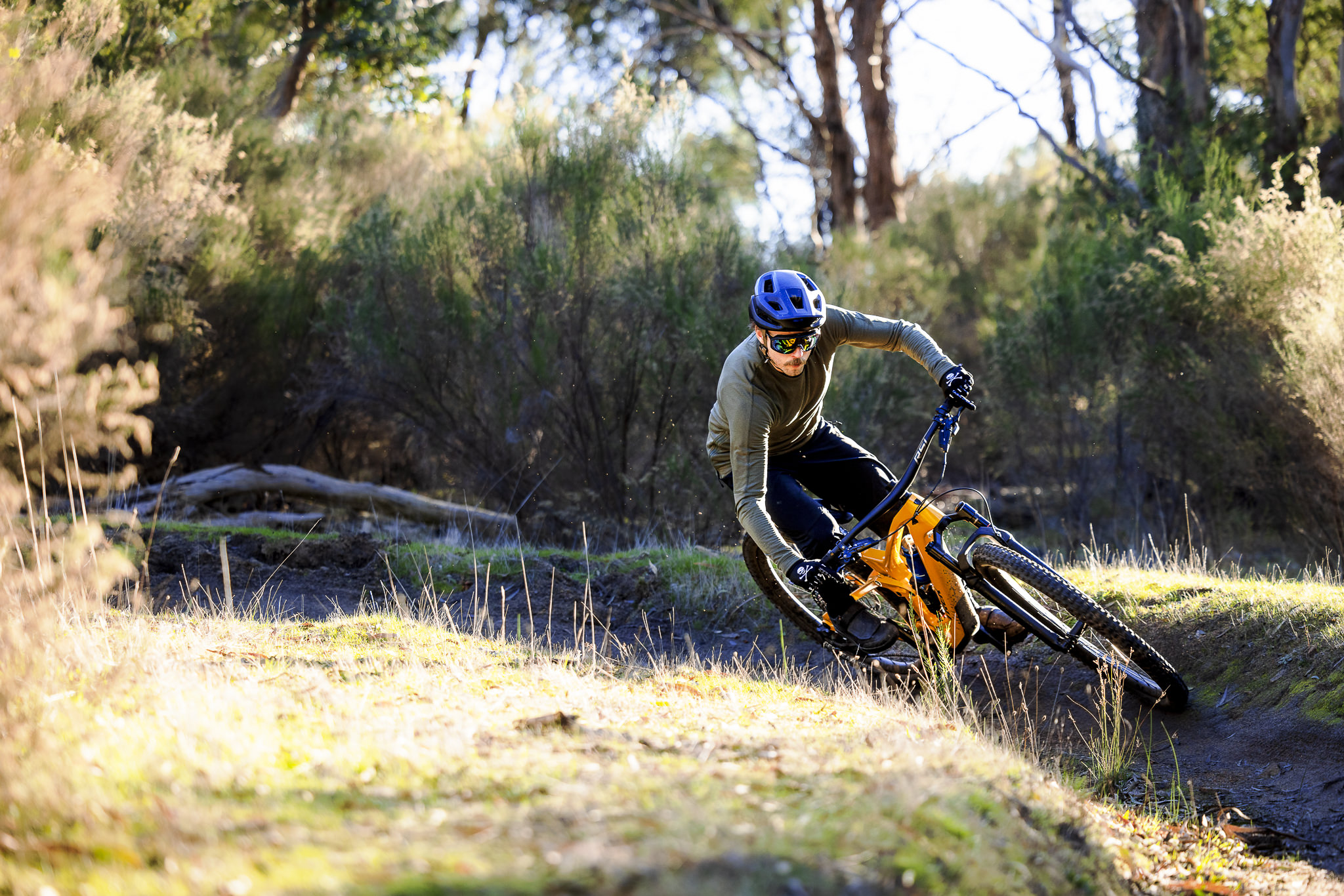
The Fuel EXe is no doubt the better option if you’re riding in a group with regular mountain bikes. It’s quiet and stealthy, so it’s less out of place. And with the motor set to the lower assist modes, you’ll be riding at similar speeds to everyone else.
If everyone in your riding group has a full-powered e-MTB however, you’ll be putting in considerably more effort with the Fuel EXe. You’ll need to make use of the highest assist setting, which tends to drain the 360Wh battery quite quickly.
Speaking of, we actually had both the Fuel EXe and the Rail during a big backcountry ride around Mt Buller. On the final climb back to the village, the Fuel EXe’s battery ran flat, while the Rail finished with 50% left in the tank. Put simply, the Rail offers you more capacity for long rides with plenty of elevation gain. That makes it the better option if epic rides in the mountains are on the agenda, particularly if you’re going to be riding with other e-MTBs.
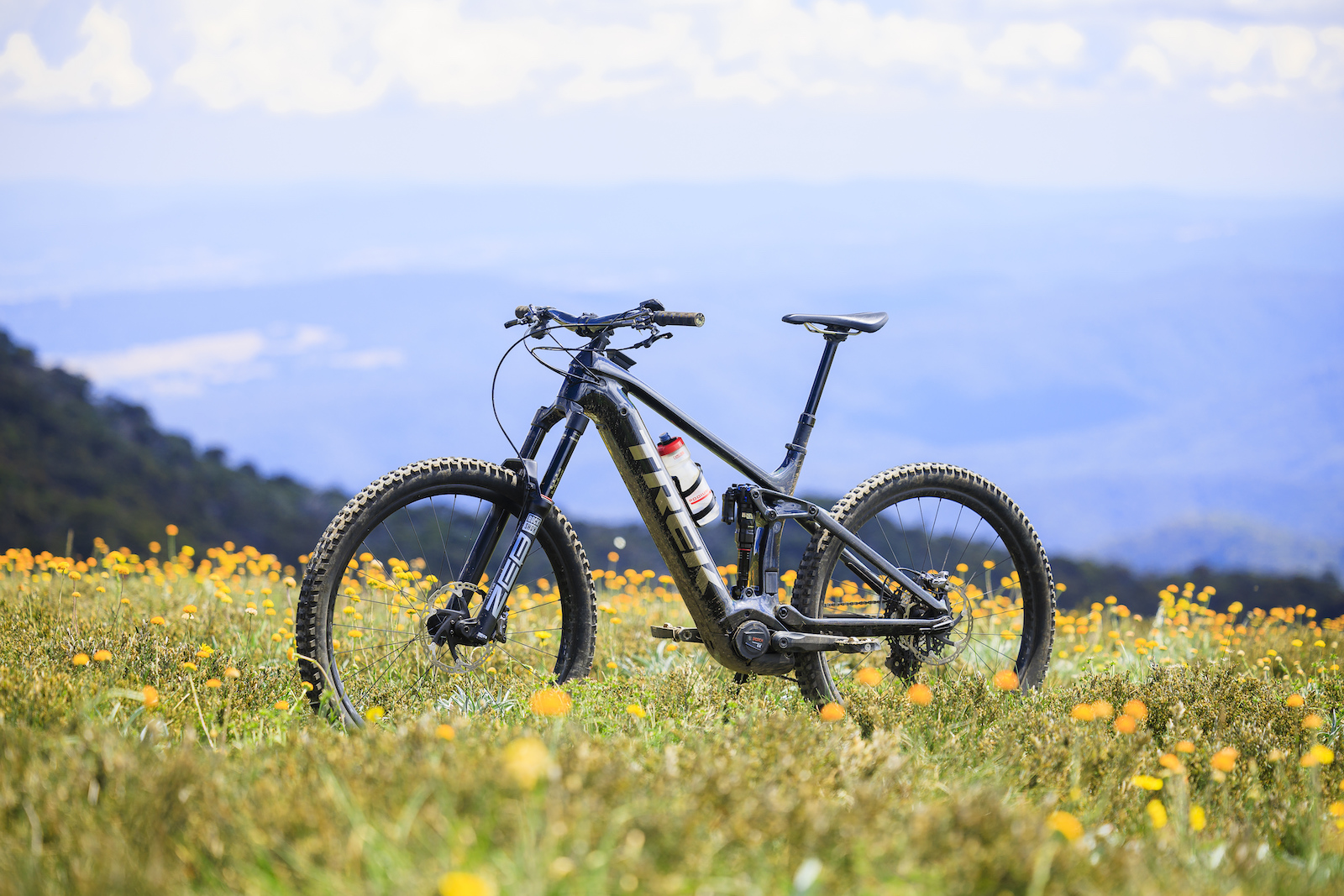
Flow’s Verdict
The latest generation Trek Rail continues to be one of the best handling full-powered e-MTBs we’ve tested.
The cornerstone is its terrific suspension performance, which offers excellent small-bump sensitivity and grip with a responsive feel all the way throughout the travel. Indeed the way it manages to balance big-hit compliance while still giving good pop is mighty impressive. Along with its stout chassis, long wheelbase and burly build kit, the Rail is capable of monster trucking its way down some pretty gnarly descents.
It isn’t a total barge on flowier singletrack however, which is largely down to its taut carbon frame, responsive suspension and short chainstays. Certainly for a 24kg e-MTB, it’s one of the more intuitive and fun bikes to ride.
It’s a mighty fine technical climber too. The powerful Bosch motor is responsive and intuitive, while the 750Wh battery offers loads of range for proper all-day rides in the mountains.
We reckon it would benefit a steeper seat angle, and given how many frame sizes Trek offers in its regular mountain bike range, it’d be great to see the Rail produced in a similar range of sizes. And while the majority of the build kit on the Rail 9.8 XT proven to be solid, we were disappointed to encounter a glaring problem with the battery on our test bike. This is an expensive bike after all, so we have high expectations.
Once that issue was sorted, the Rail has proven to be a solid performer that we’ve thoroughly enjoyed on some epic rides over the summer season.
We wouldn’t necessarily recommend it for smaller riders or those who are newer to mountain biking, as its overall heft and raked-out wheelbase can make it a handful on more mellow terrain. Those riders will likely be better served by the lighter Fuel EXe, or perhaps even an alloy Rail with its slightly more moderate geometry.
But if you’re after a powerful and highly capable e-MTB that thrives on enduro-type trails, the Rail delivers control and composure in spades, especially when things get steep, fast and chunky.
